ASUSTeK Computer MTG20 Personal Computer User Manual book
ASUSTeK Computer Inc Personal Computer book
Contents
- 1. Manual Part 1
- 2. Manual Part 2
Manual Part 1
www.dell.com | support.dell.com
Dell™ XPS One™ Owner’s Manual
ModelMTG
book.book Page 1 Thursday, August 16, 2007 9:44 AM

Notes, Notices, and Cautions
NOTE: A NOTE indicates important information that helps you make better use of
your computer.
NOTICE: A NOTICE indicates either potential damage to hardware or loss of data
and tells you how to avoid the problem.
CAUTION: A CAUTION indicates a potential for property damage, personal injury,
or death.
____________________
Information in this document is subject to change without notice.
© 2007 Dell Inc. All rights reserved.
Reproduction in any manner whatsoever without the written permission of Dell Inc. is strictly
forbidden.
Trademarks used in this text: Dell, the DELL logo, Inspiron, XPS, Dell Precision, Dimension, OptiPlex,
Latitude, PowerEdge, PowerVault, PowerApp, and Dell OpenManage are trademarks of Dell Inc.;
Intel, Pentium, and Celeron are registered trademarks of Intel Corporation; Microsoft, Windows,
Windows Server, MS-DOS and Windows Vista are either trademarks or registered trademarks of
Microsoft Corporation in the United States and/or other countries.
Other trademarks and trade names may be used in this document to refer to either the entities claiming
the marks and names or their products. Dell Inc. disclaims any proprietary interest in trademarks and
trade names other than its own.
ModelMTG
September 2007 P/N CU557 Rev. A00
book.book Page 2 Thursday, August 16, 2007 9:44 AM

Contents 3
Contents
1 Finding Information . . . . . . . . . . . . . . . . . . 9
2 About Your Computer . . . . . . . . . . . . . . . 15
Front View of the Computer . . . . . . . . . . . . . . . 15
Back View of the Computer . . . . . . . . . . . . . . . 17
Power Cable Routing . . . . . . . . . . . . . . . . 20
Optional TV Input Device (For Use With Optional
TV Tuner) . . . . . . . . . . . . . . . . . . . . . . . . . 21
3 Setting Up Your Computer . . . . . . . . . . . . 23
Installing Your Computer in an Enclosure . . . . . . . 23
Connecting to the Internet . . . . . . . . . . . . . . . 24
Setting Up Your Internet Connection . . . . . . . . 24
Transferring Information to a New Computer . . . . . 25
Setting Up a Printer . . . . . . . . . . . . . . . . . . . 26
Printer Cable . . . . . . . . . . . . . . . . . . . . 26
Connecting a USB Printer . . . . . . . . . . . . . 27
book.book Page 3 Thursday, August 16, 2007 9:44 AM

4Contents
Power Protection Devices . . . . . . . . . . . . . . . 28
Surge Protectors . . . . . . . . . . . . . . . . . . 28
Line Conditioners . . . . . . . . . . . . . . . . . . 28
Uninterruptible Power Supplies . . . . . . . . . . 28
Using the Media Card Reader . . . . . . . . . . . . . . 29
4 Using Multimedia . . . . . . . . . . . . . . . . . . 31
Using the Disc Drive . . . . . . . . . . . . . . . . . . . 31
Media Control Buttons . . . . . . . . . . . . . . . 32
Disc and Disc-Slot Indicators . . . . . . . . . . . 33
CD and DVD Software . . . . . . . . . . . . . . . . . . 33
Copying CD, DVD, and Blu-ray Disc™ (BD)
Media . . . . . . . . . . . . . . . . . . . . . . . . 34
Helpful Tips . . . . . . . . . . . . . . . . . . . . . 37
Adjusting the Volume . . . . . . . . . . . . . . . . 38
Adjusting the Picture . . . . . . . . . . . . . . . . 38
Enabling S/PDIF Digital Audio . . . . . . . . . . . . . 38
Enabling S/PDIF in the Windows
Audio Driver . . . . . . . . . . . . . . . . . . . . 39
Setting Up the Cyberlink (CL) Headphones . . . . . . . 39
5 Using the Optional Wireless Keyboard
and Mouse . . . . . . . . . . . . . . . . . . . . . . . 41
Media Control Keys . . . . . . . . . . . . . . . . . . . 42
Using the Touch Pad . . . . . . . . . . . . . . . . . . . 43
Customizing the Touch Pad . . . . . . . . . . . . . 44
book.book Page 4 Thursday, August 16, 2007 9:44 AM

Contents 5
Re-Syncing Your Optional Wireless Mouse or
Keyboard with Your Computer . . . . . . . . . . . . . 44
Key Combinations . . . . . . . . . . . . . . . . . . . . 46
6 Using the Display . . . . . . . . . . . . . . . . . . 47
Adjusting Brightness . . . . . . . . . . . . . . . . . . 47
Making Images and Text Look Bigger or Sharper . . . 47
7 Cleaning Your Computer . . . . . . . . . . . . . 49
Computer and Display . . . . . . . . . . . . . . . . . . 49
CDs and DVDs . . . . . . . . . . . . . . . . . . . . . . 49
Keyboard and Touch Pad . . . . . . . . . . . . . . . . 50
8 Troubleshooting . . . . . . . . . . . . . . . . . . . 51
Solving Problems . . . . . . . . . . . . . . . . . . . . 51
Battery Problems . . . . . . . . . . . . . . . . . . 51
Display Problems . . . . . . . . . . . . . . . . . . 51
Drive Problems . . . . . . . . . . . . . . . . . . . 52
E-Mail and Internet Problems . . . . . . . . . . . 53
Error Messages . . . . . . . . . . . . . . . . . . 54
IEEE 1394 Device Problems . . . . . . . . . . . . 55
Keyboard Problems . . . . . . . . . . . . . . . . 55
Lockups and Software Problems . . . . . . . . . 56
Memory Problems . . . . . . . . . . . . . . . . . 58
Mouse Problems . . . . . . . . . . . . . . . . . . 58
Network Problems . . . . . . . . . . . . . . . . . 60
Power Problems . . . . . . . . . . . . . . . . . . 60
book.book Page 5 Thursday, August 16, 2007 9:44 AM

6Contents
Printer Problems . . . . . . . . . . . . . . . . . . 61
Scanner Problems . . . . . . . . . . . . . . . . . 62
Sound and Speaker Problems . . . . . . . . . . . 62
Touch Pad Problems . . . . . . . . . . . . . . . . 64
9 Dell Diagnostics . . . . . . . . . . . . . . . . . . . 65
When to Use the Dell Diagnostics . . . . . . . . . . . 65
Starting the Dell Diagnostics From Your
Hard Drive . . . . . . . . . . . . . . . . . . . . . . . . 65
Starting the Dell Diagnostics From the Drivers and
Utilities Media . . . . . . . . . . . . . . . . . . . . . . 66
Dell Diagnostics Main Menu . . . . . . . . . . . . . . 67
10 System Setup . . . . . . . . . . . . . . . . . . . . . . 69
Overview . . . . . . . . . . . . . . . . . . . . . . . . . 69
Entering System Setup . . . . . . . . . . . . . . . . . . 69
System Setup Screen . . . . . . . . . . . . . . . . 69
System Setup Options . . . . . . . . . . . . . . . . . . 70
Boot Sequence . . . . . . . . . . . . . . . . . . . . . 73
Option Settings . . . . . . . . . . . . . . . . . . . 73
Changing the Boot Sequence for the
Current Boot . . . . . . . . . . . . . . . . . . . . 73
Changing the Boot Sequence for
Future Boots . . . . . . . . . . . . . . . . . . . . 74
book.book Page 6 Thursday, August 16, 2007 9:44 AM

Contents 7
11 Reinstalling Software . . . . . . . . . . . . . . . 75
Drivers . . . . . . . . . . . . . . . . . . . . . . . . . . 75
What Is a Driver? . . . . . . . . . . . . . . . . . . 75
Identifying Drivers . . . . . . . . . . . . . . . . . 76
Reinstalling Drivers and Utilities . . . . . . . . . . 76
Troubleshooting Software and Hardware Problems
in the Microsoft® Windows® Vista™
Operating Systems . . . . . . . . . . . . . . . . . . . 78
Restoring Your Operating System . . . . . . . . . . . . 78
Using Microsoft Windows System Restore . . . . 78
Using Dell™ Factory Image Restore . . . . . . . . 80
Using the Operating System Media . . . . . . . . 81
12 Specifications . . . . . . . . . . . . . . . . . . . . . 83
13 Getting Help . . . . . . . . . . . . . . . . . . . . . . 89
Obtaining Assistance . . . . . . . . . . . . . . . . . . 89
Technical Support and Customer Service . . . . . 90
DellConnect . . . . . . . . . . . . . . . . . . . . 90
Online Services . . . . . . . . . . . . . . . . . . 90
AutoTech Service . . . . . . . . . . . . . . . . . 91
Automated Order-Status Service . . . . . . . . . 91
Problems With Your Order . . . . . . . . . . . . . . . 91
Product Information . . . . . . . . . . . . . . . . . . . 92
Returning Items for Warranty Repair or Credit . . . . . 92
Before You Call . . . . . . . . . . . . . . . . . . . . . 93
Contacting Dell . . . . . . . . . . . . . . . . . . . . . 95
book.book Page 7 Thursday, August 16, 2007 9:44 AM

8Contents
14 Appendix . . . . . . . . . . . . . . . . . . . . . . . . . 97
FCC Notice (U.S. Only) . . . . . . . . . . . . . . . . . . 97
FCC Class B . . . . . . . . . . . . . . . . . . . . . 97
Glossary . . . . . . . . . . . . . . . . . . . . . . . . . . . . . 99
Index . . . . . . . . . . . . . . . . . . . . . . . . . . . . . . 117
book.book Page 8 Thursday, August 16, 2007 9:44 AM
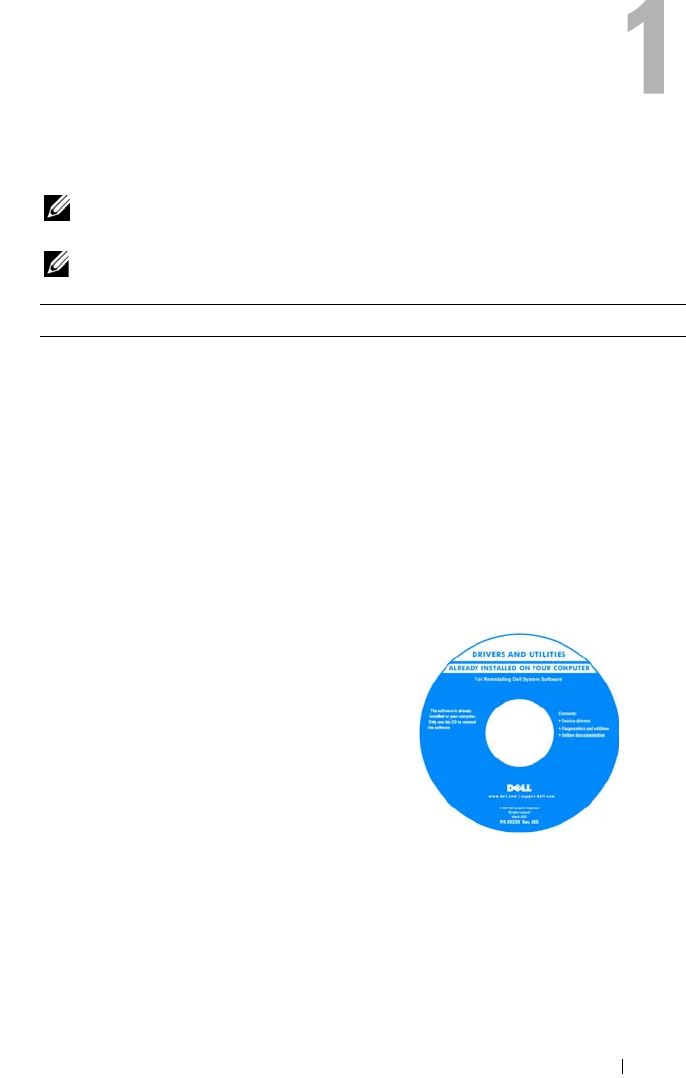
Finding Information 9
Finding Information
NOTE: Some features or media may be optional and may not ship with your
computer. Some features or media may not be available in certain countries.
NOTE: Additional information may ship with your computer.
What Are You Looking For? Find It Here
• A diagnostic program for my computer
• Drivers for my computer
• Desktop System Software (DSS)
Drivers and Utilities Media
Documentation and drivers are already
installed on your computer. You can use
the media to reinstall drivers (see
"Reinstalling Drivers and Utilities" on
page 76), to run the Dell Diagnostics (see
"Dell Diagnostics" on page 65).
Readme files may be included on your
media to provide last-minute updates
about technical changes to your computer
or advanced technical-reference material
for technicians or experienced users.
NOTE: Drivers and documentation updates
can be found at support.dell.com.
book.book Page 9 Thursday, August 16, 2007 9:44 AM

10 Finding Information
• Warranty information
• Terms and Conditions (U.S. only)
• Safety instructions
• Regulatory information
• Ergonomics information
• End User License Agreement
Dell™ Product Information Guide
• How to set up my computer
Setup Diagram
NOTE: The appearance of your setup
diagram may vary.
What Are You Looking For? Find It Here
book.book Page 10 Thursday, August 16, 2007 9:44 AM
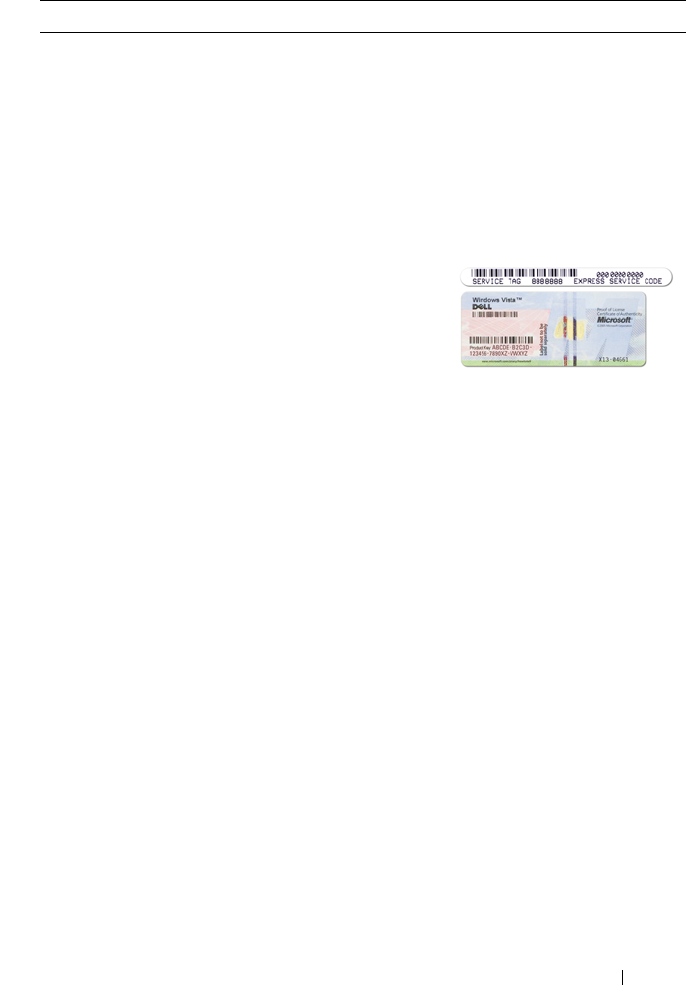
Finding Information 11
• Service Tag and Express Service Code
• Microsoft Windows License Label
Service Tag and Microsoft
®
Windows
®
License
These labels are located on your
computer.
• Use the Service Tag to identify your
computer when you use
support.dell.com
or contact support.
• Enter the Express Service Code to direct
your call when contacting support.
NOTE: As an increased security measure,
the newly designed Microsoft Windows
license label incorporates a missing portion
or "hole" to discourage removal of the label.
What Are You Looking For? Find It Here
book.book Page 11 Thursday, August 16, 2007 9:44 AM

12 Finding Information
• Solutions — Troubleshooting hints and
tips, articles from technicians, and
online courses, frequently asked
questions
• Community — Online discussion with
other Dell customers
• Upgrades — Upgrade information for
components, such as memory, the hard
drive, and the operating system
• Customer Care — Contact information,
service call and order status, warranty,
and repair information
• Service and support — Service call
status and support history, service
contract, online discussions with
technical support
• Dell Technical Update Service —
Proactive e-mail notification of software
and hardware updates for your computer
• Reference — Computer documentation,
details on my computer configuration,
product specifications, and white papers
• Downloads — Certified drivers, patches,
and software updates
Dell Support Website — support.dell.com
NOTE: Select your region or business
segment to view the appropriate support
site.
• Desktop System Software (DSS)— If
you reinstall the operating system for
your computer, you should also reinstall
the DSS utility. DSS provides critical
updates for your operating system and
support for processors, optical drives,
USB devices, and so on. DSS is
necessary for correct operation of your
Dell computer. The software
automatically detects your computer
and operating system and installs the
updates appropriate for your
configuration.
To download Desktop System Software:
1
Go to
support.dell.com
, select your
region or business segment, and enter
your Service Tag.
2
Select
Drivers & Downloads
and click
Go
.
3
Click your operating system and search
for the keyword
Desktop System
Software
.
NOTE: The support.dell.com user interface
may vary depending on your selections.
What Are You Looking For? Find It Here
book.book Page 12 Thursday, August 16, 2007 9:44 AM
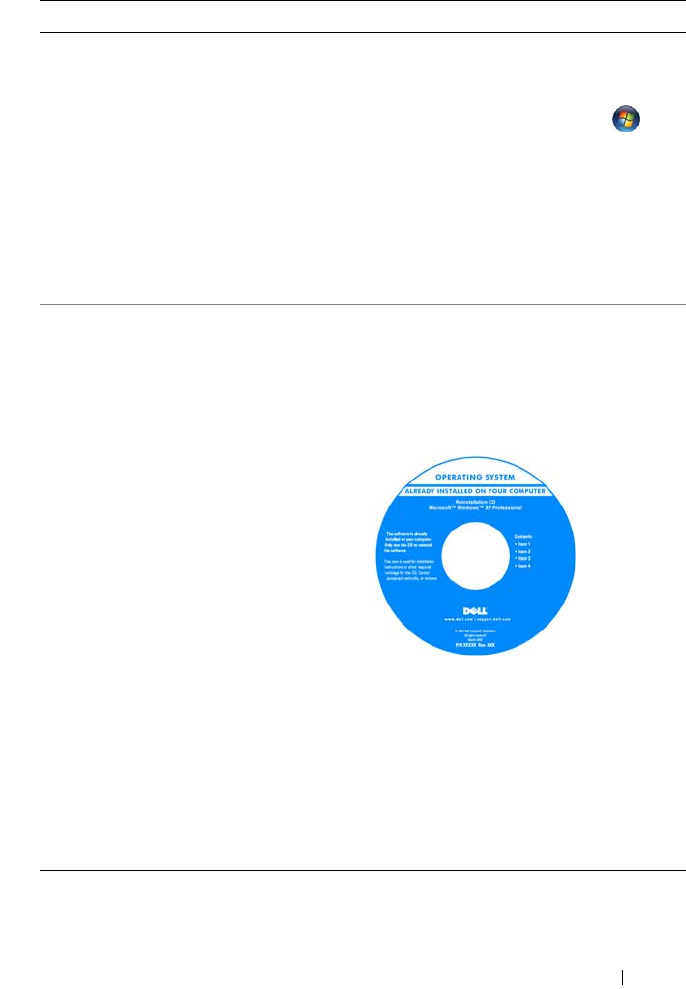
Finding Information 13
• How to use your Windows™ operating
system
• How to work with programs and files
• How to personalize my desktop
Windows Help and Support
1
To access Windows Help and Support:
• In Windows Vista™, click the
Windows Vista Start button
and
click
Help and Support
.
2
Type a word or phrase that describes
your problem, and then click the arrow
icon.
3
Click the topic that describes your
problem.
4
Follow the instructions on the screen.
• How to reinstall my operating system
Operating System Media
The operating system is already installed
on your computer. To reinstall your
operating system, use the Operating
System CD. See "Restoring Your
Operating System" on page 78.
After you reinstall your operating system,
use the Drivers and Utilities CD to
reinstall drivers for the devices that came
with your computer.
Your operating system product key label is
located on your computer.
NOTE: The color of your CD varies based
on the operating system you ordered.
What Are You Looking For? Find It Here
book.book Page 13 Thursday, August 16, 2007 9:44 AM

14 Finding Information
book.book Page 14 Thursday, August 16, 2007 9:44 AM
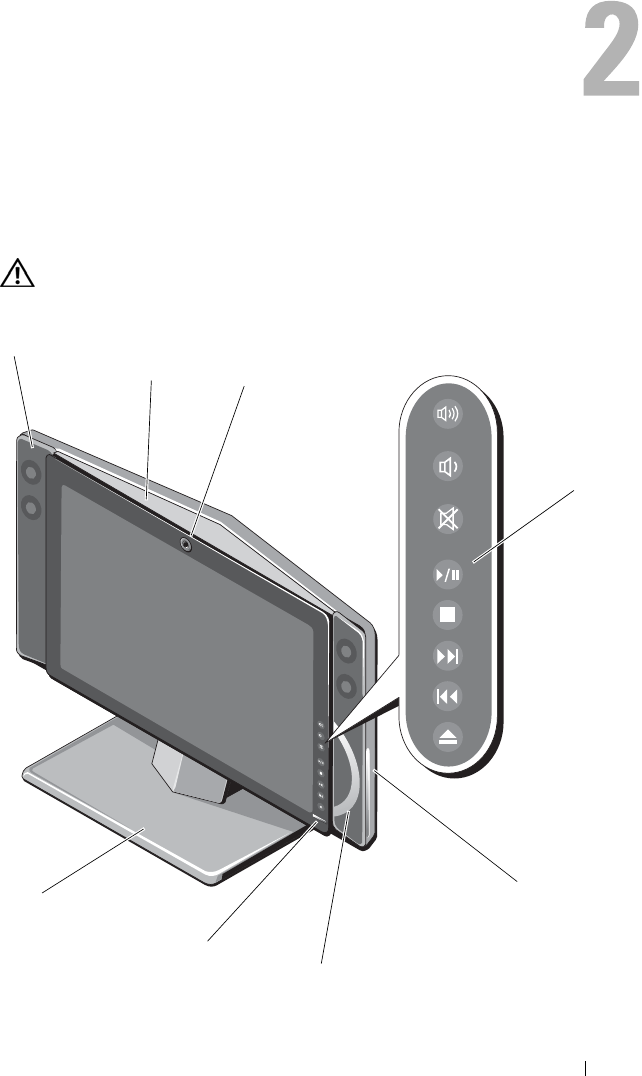
About Your Computer 15
About Your Computer
Front View of the Computer
CAUTION: Ensure that none of the computer air vents are blocked. Blocking them
would cause serious thermal problems.
23
4
5
6
1
7
8
book.book Page 15 Thursday, August 16, 2007 9:44 AM
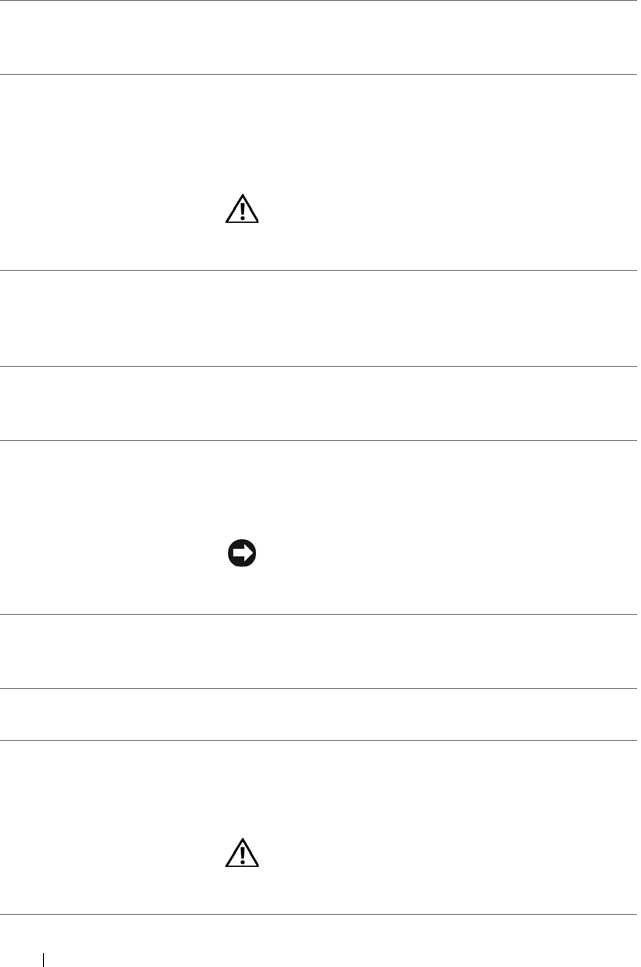
16 About Your Computer
1 speakers (2) To adjust the volume of the integrated speakers, press
the appropriate media control buttons (see "Media
Control Buttons" on page 32 for more information).
2 air vents Internal fans create airflow through the vents to
prevent the computer from overheating. The computer
turns the fans on when the computer gets hot. Fan
noise is normal and does not indicate a problem with
the fans or the computer.
CAUTION: Ensure that none of the computer air
vents are blocked. Blocking them would cause
serious thermal problems.
3 camera/ microphone
array
Built-in camera and microphone array for video
capture, conferencing, and chat. When the
camera/microphone array is in use, the blue back-light
lights up.
4 media control buttons Control CD, DVD, Blu-ray Disc™ (BD), and Media
Player play. See "Media Control Buttons" on page 32
for more information.
5 disc slot Insert CD, DVD, or Blu-ray Disc™ (BD) as supported
by your disc drive. The disc-slot indicator lights up
when no disc is in the drive; see "Disc and Disc-Slot
Indicators" on page 33 for more information.
NOTICE: The optical drive does not support 8cm
media. Do not insert 8cm media into the optical
drive slot.
6 disc indicator The disc indicator lights up when a disc is in the drive.
See "Disc and Disc-Slot Indicators" on page 33 for
more information.
7 display power button Press to turn the display on and off without changing
the overall operating state of the computer.
8 computer stand Use the stand to tilt the display to your preferred angle.
It can be rotated from 5º towards you to 25º back. The
stand provides stability to the computer; it is not a
removable part.
CAUTION: The computer stand should remain
installed at all times to ensure maximum system
stability.
book.book Page 16 Thursday, August 16, 2007 9:44 AM
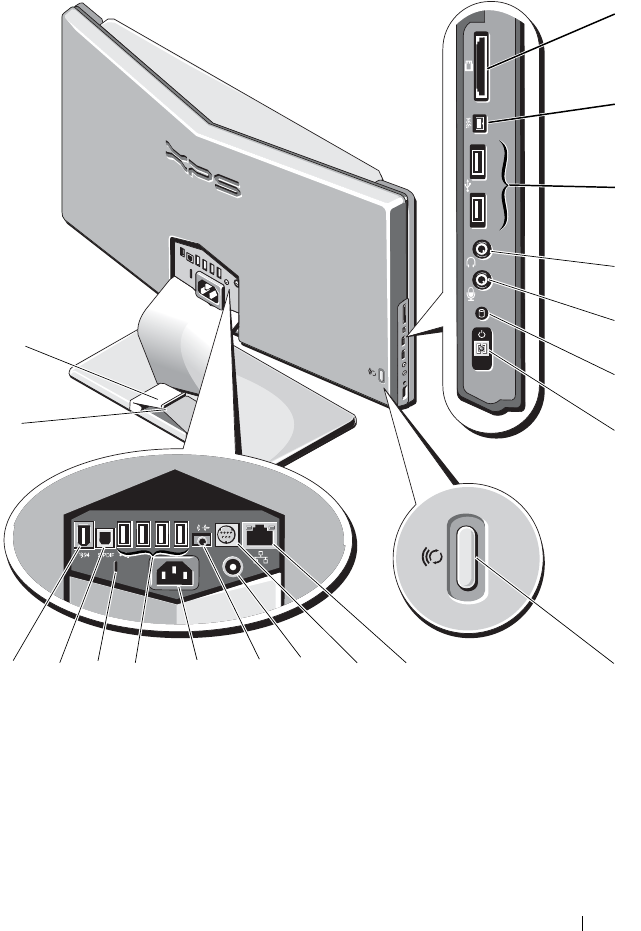
About Your Computer 17
Back View of the Computer
1
2
3
4
6
5
7
813141617
19
11 9
12
18
10
15
book.book Page 17 Thursday, August 16, 2007 9:44 AM

18 About Your Computer
1 Media Card Reader Provides a fast and convenient way to view and share digital
photos, music, and videos stored on a memory card. The
Media Card Reader reads the following digital memory
cards:
• Secure Digital (SD) memory card
•SDIO card
• MultiMediaCard (MMC)
•Memory Stick
• Memory Stick PRO
•xD-Picture Card
• Hi Speed-SD
• Hi Density-SD
2 mini IEEE 1394
connector
Attach high-speed serial multimedia devices, such as digital
video cameras.
3 USB 2.0
connectors (2)
Use the side USB connectors for devices that you connect
occasionally, such as joysticks or cameras, or for bootable USB
devices (see "System Setup Options" on page 70 for more
information on booting to a USB device). It is
recommended that you use the back USB connectors for
devices that typically remain connected, such as printers
and keyboards.
4 headphone/line-
out connector
Use the headphone/line-out connector to attach
headphones and most kinds of speakers.
5 microphone/line-in
connector
Use the microphone/line-in connector to attach a personal
computer microphone for voice or musical input into a
sound or telephony program.
6 drive activity light The drive activity light is on when the computer reads data
from or writes data to the hard drive. The light might also
be on when a device such as an optical drive is operating.
7 power button,
power light
Press the power button to turn on the computer. The light
in the center of this button indicates power state. See
"Controls and Lights" on page 87 for more information.
NOTICE: To avoid losing data, do not use the power
button to turn off the computer. Instead, perform an
operating system shutdown.
book.book Page 18 Thursday, August 16, 2007 9:44 AM

About Your Computer 19
8 computer sync
button
To re-sync your optional wireless keyboard and mouse to
your computer, press the sync button on the rear of your
computer, then press the sync button on the device that
you wish to use. See "Re-Syncing Your Optional Wireless
Mouse or Keyboard with Your Computer" on page 44.
9 network adapter
connector
To attach your computer to a network or broadband device,
connect one end of a network cable to either a network port
or your network or broadband device. Connect the other
end of the network cable to the network adapter connector
on the back panel of your computer. A click indicates that
the network cable has been securely attached.
NOTE: Do not plug a telephone cable into the network
connector.
network activity light: Flashes a yellow light when the
computer is transmitting or receiving network data. A high
volume of network traffic may make this light appear to be
in a steady "on" state.
link integrity light:
Green — A good connection exists between the network
and the computer.
Off — The computer is not detecting a physical
connection to the network.
10 optional TV input-
device connector
10-pin connector to attach the optional TV-input device.
The device is only necessary if you will not be connecting
your TV via the optional TV-in connector.
TV input-device connectors: S-video, composite video, and
audio connectors, and IR blaster.
11 TV-in connector TV-in connector — only supported on systems with
optional TV tuner card.
12 2.0 audio out
connector
Connect speakers for 2.0 audio.
13 power connector Insert the power cable.
14 USB 2.0
connectors (4)
Use the back USB connectors for devices that typically
remain connected, such as printers and keyboards.
It is recommended that you use the side USB connectors
for devices that you connect occasionally, such as joysticks
or cameras.
book.book Page 19 Thursday, August 16, 2007 9:44 AM
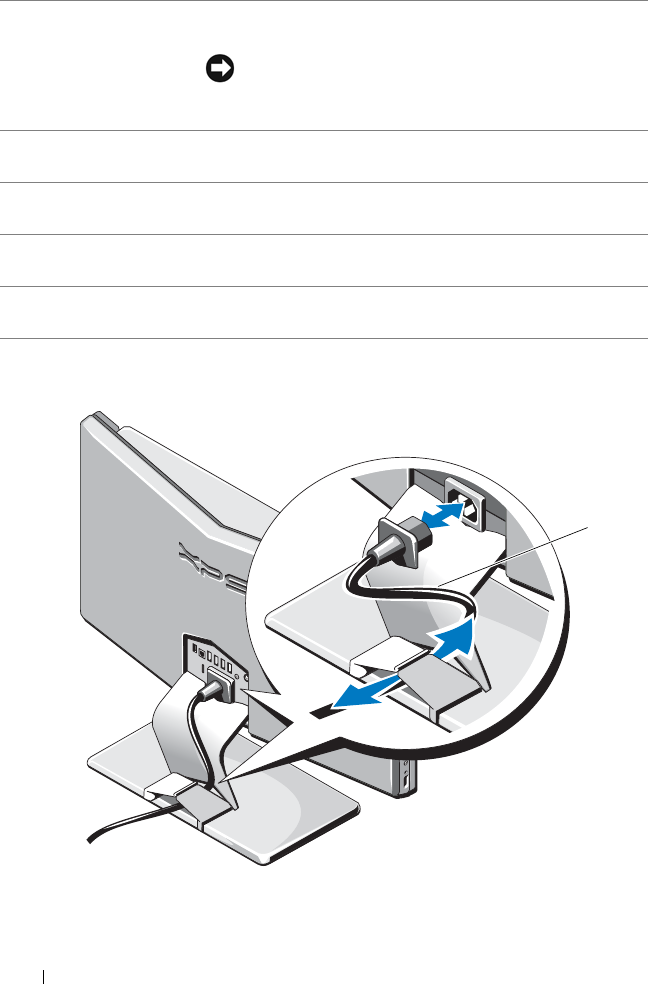
20 About Your Computer
Power Cable Routing
15 security cable slot Lets you attach a commercially available antitheft device to
the computer.
NOTICE: Before you buy an antitheft device, ensure
that it works with the security cable slot on your
computer.
16 S/PDIF connector Use the S/PDIF connector to transmit digital audio
without going through an analog audio conversion process.
17 IEEE 1394
connector
Attach high-speed serial multimedia devices, such as digital
video cameras.
18 Service Tag Use the Service Tag to identify your computer when you
access the Dell Support website or contact support.
19 cable routing flaps Route power cord and other rear cables through these flaps
to improve the appearance of your cables.
1 power cable
1
book.book Page 20 Thursday, August 16, 2007 9:44 AM
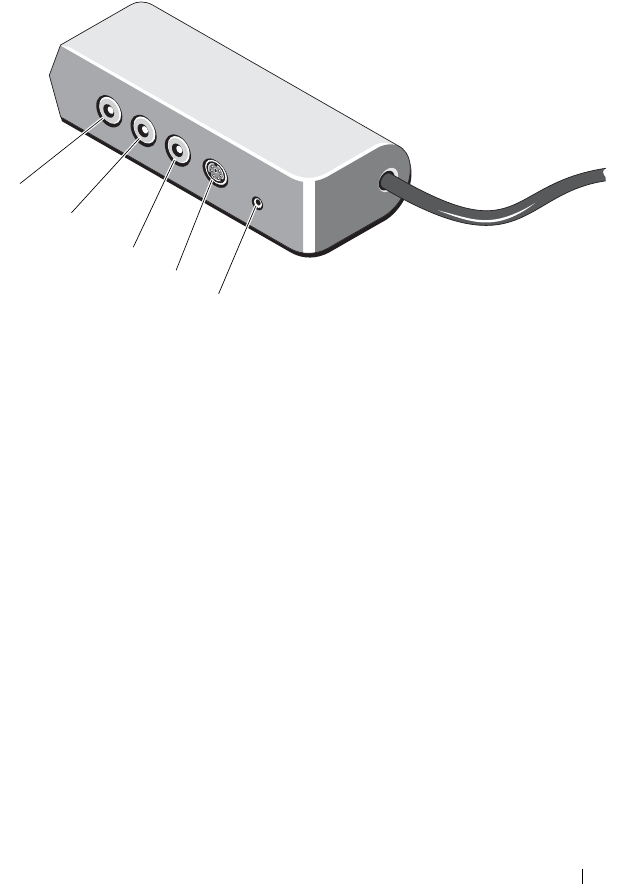
About Your Computer 21
Optional TV Input Device (For Use With Optional
TV Tuner)
1 composite video 2 left audio output connector
3 right audio output connector 4 S-video connector
5 IR blaster
5
4
3
1
2
book.book Page 21 Thursday, August 16, 2007 9:44 AM

22 About Your Computer
book.book Page 22 Thursday, August 16, 2007 9:44 AM

Setting Up Your Computer 23
Setting Up Your Computer
Installing Your Computer in an Enclosure
Installing your computer in an enclosure can restrict the airflow and impact
your computer’s performance, possibly causing it to overheat. Follow the
guidelines below when installing your computer in an enclosure:
NOTICE: The operating temperature specifications indicated in this manual
reflects the maximum ambient operating temperature. The room ambient
temperature needs to be a consideration when installing your computer in an
enclosure. For example, if the ambient room temperature is at 25°C (77°F),
depending on your computer’s specifications, you only have 5° to 10°C (9° to 18°F)
temperature margin before you reach your computer’s maximum operating
temperature. For details about your computer’s specifications, see "Specifications"
on page 83.
• Leave a 10.2 cm (4 in) minimum clearance on all vented sides of the
computer to permit the airflow required for proper ventilation.
• If your enclosure has doors, they need to be of a type that allows at least
30 percent airflow through the enclosure (front and back).
• If your computer is installed in a corner on a desk or under a desk, leave at
least 5.1 cm (2 in) clearance from the back of the computer to the wall to
permit the airflow required for proper ventilation.
NOTICE: Do not install your computer in an enclosure that does not allow airflow.
Restricting the airflow impacts your computer’s performance, possibly causing it to
overheat.
book.book Page 23 Thursday, August 16, 2007 9:44 AM

24 Setting Up Your Computer
Connecting to the Internet
NOTE: ISPs and ISP offerings vary by country.
To connect to the Internet, you need a network connection and an Internet
service provider (ISP). Your ISP will offer one or more of the following
Internet connection options:
• DSL connections that provide high-speed Internet access through your
existing telephone line or cellular telephone service. With a DSL
connection, you can access the Internet and use your telephone on the
same line simultaneously.
• Cable modem connections that provide high-speed Internet access
through your local cable TV line.
• Satellite modem connections that provide high-speed Internet access
through a satellite television system.
• Wireless LAN connections that provide Internet access using Bluetooth
®
wireless technology.
If you are using a DSL or cable/satellite modem connection, contact your ISP
or cellular telephone service for setup instructions.
Setting Up Your Internet Connection
To set up an Internet connection with a provided ISP desktop shortcut:
1
Save and close any open files, and exit any open programs.
2
Double-click the ISP
icon on the Microsoft
®
Windows
®
desktop.
3
Follow the instructions on the screen to complete the setup.
If you do not have an ISP icon on your desktop or if you want to set up an
Internet connection with a different ISP, perform the steps in the following
section.
NOTE: If you are having problems connecting to the Internet, see "E-Mail and
Internet Problems" on page 53. If you cannot connect to the Internet but have
successfully connected in the past, the ISP might have a service outage. Contact
your ISP to check the service status, or try connecting again later.
book.book Page 24 Thursday, August 16, 2007 9:44 AM

Setting Up Your Computer 25
NOTE: Have your ISP information ready. If you do not have an ISP, the Connect to
the Internet wizard can help you get one.
1
Save and close any open files, and exit any open programs.
2
Click the Windows Vista Start button , and click
Control Panel
.
3
Under
Network and Internet,
click
Connect to the Internet
.
The
Connect to the Internet
window appears.
4
Click
Broadband (PPPoE)
for a DSL, satellite modem, cable TV modem,
or Bluetooth wireless technology connection.
NOTE: If you do not know which type of connection to select, click Help me choose
or contact your ISP.
5
Follow the instructions on the screen and use the setup information
provided by your ISP to complete the setup.
Transferring Information to a New Computer
You can use your operating system "wizards" to help you transfer files and
other data from one computer to another—for example, from an old
computer to a new computer.
The Microsoft Windows Vista™ operating system provides the Windows Easy
Transfer application to move data from a source computer to a new computer.
You can transfer data, such as:
• E-mail messages
• Toolbar settings
• User accounts
• Internet bookmarks
You can transfer the data to the new computer over a network or serial
connection, or you can store it on removable media, such as a writable CD,
for transfer to the new computer.
book.book Page 25 Thursday, August 16, 2007 9:44 AM

26 Setting Up Your Computer
NOTE: For more information about options available with Windows Easy Transfer,
see Microsoft Knowledge Base Article #928634, titled How to use Windows Easy
Transfer to migrate files and settings from one Windows-based computer to
another Windows Vista-based computer. This information may not be available in
certain countries.
1
Click the Windows Vista Start button , and then click
Transfer files
and settings
→
Start Windows Easy Transfer.
2
In the
User Account Control
dialog box, click
Continue
.
3
Click
Start a new transfer
or
Continue a transfer in progress
.
Follow the instructions provided on the screen by the Windows Easy Transfer
wizard.
Setting Up a Printer
NOTICE: Complete the operating system setup before you connect a printer to the
computer.
See the documentation that came with the printer for setup information,
including how to:
• Obtain and install updated drivers.
• Connect the printer to the computer.
• Load paper and install the toner or ink cartridge.
For technical assistance, refer to the printer owner's manual or contact the
printer manufacturer.
Printer Cable
Your printer connects to your computer with a USB cable. Your printer may
not come with a printer cable, so if you purchase a cable separately, ensure
that it is compatible with your printer and computer. If you purchased a
printer cable at the same time you purchased your computer, the cable may
arrive in the computer’s shipping box.
book.book Page 26 Thursday, August 16, 2007 9:44 AM
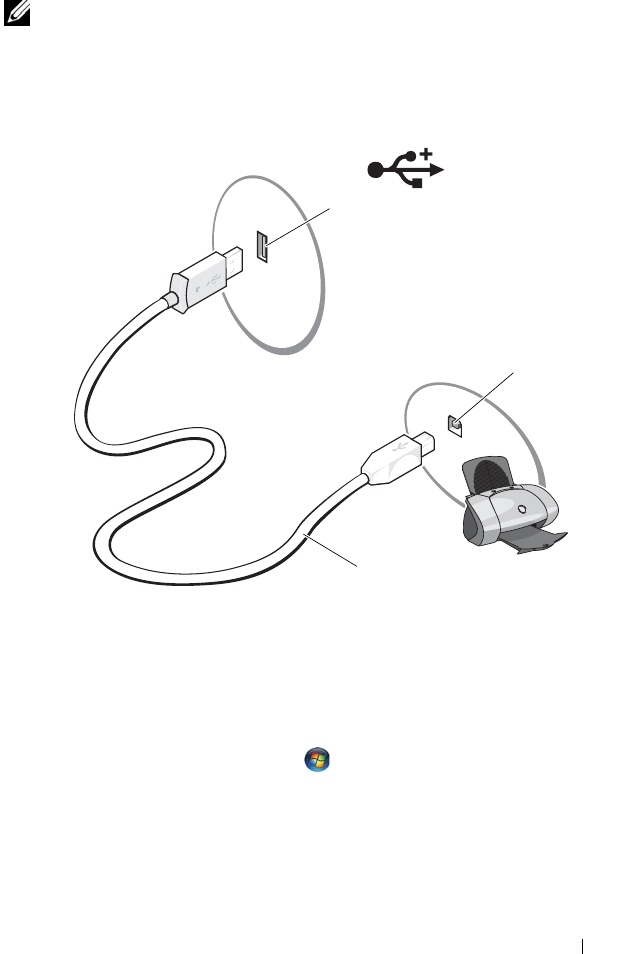
Setting Up Your Computer 27
Connecting a USB Printer
NOTE: You can connect USB devices while the computer is turned on.
1
Complete the operating system setup if you have not already done so.
2
Attach the USB printer cable to the USB connectors on the computer and
the printer. The connectors fit only one way.
3
Turn on the printer.
4
If your computer is running the Windows Vista™ operating system, click
the Windows Vista Start button , and click
Network
→
Add a printer
to
start the Add Printer Wizard.
5
Install the printer driver if necessary. See "Reinstalling Drivers and
Utilities" on page 76 and the documentation that came with your printer.
1 USB connector on computer 2 USB connector on printer
3 USB printer cable
2
1
3
book.book Page 27 Thursday, August 16, 2007 9:44 AM

28 Setting Up Your Computer
Power Protection Devices
Several devices are available to protect against power fluctuations and
failures:
• Surge protectors
• Line conditioners
• Uninterruptible power supplies (UPS)
Surge Protectors
Surge protectors and power strips equipped with surge protection help
prevent damage to your computer from voltage spikes that can occur during
electrical storms or after power interruptions. Some surge protector
manufacturers include warranty coverage for certain types of damage.
Carefully read the device warranty when choosing a surge protector. A device
with a higher joule rating offers more protection. Compare joule ratings to
determine the relative effectiveness of different devices.
NOTICE: Most surge protectors do not protect against power fluctuations or
power interruptions caused by nearby lightning strikes. Disconnect the network
cable from the network wall jack during electrical storms.
Line Conditioners
NOTICE: Line conditioners do not protect against power interruptions.
Line conditioners are designed to maintain AC voltage at a fairly constant
level.
Uninterruptible Power Supplies
NOTICE: Loss of power while data is being saved to the hard drive may result in
data loss or file damage.
NOTE: To ensure maximum battery operating time, connect only your computer to a
UPS. Connect other devices, such as a printer, to a separate power strip that
provides surge protection.
A UPS protects against power fluctuations and interruptions. UPS devices
contain a battery that provides temporary power to connected devices when
AC power is interrupted. The battery charges while AC power is available. See
book.book Page 28 Thursday, August 16, 2007 9:44 AM

Setting Up Your Computer 29
the UPS manufacturer documentation for information on battery operating
time and to ensure that the device is approved by Underwriters Laboratories
(UL).
Using the Media Card Reader
Use the Media Card Reader to transfer data directly to your computer.
NOTE: A memory card is not a bootable device.
The Media Card Reader reads the following memory cards:
• Secure Digital (SD)
•SDIO
• MultiMediaCard (MMC)
• Memory Stick
• Memory Stick PRO
• xD-Picture Card
• HiSpeed-SD
• Hi Capacity-SD
book.book Page 29 Thursday, August 16, 2007 9:44 AM

30 Setting Up Your Computer
book.book Page 30 Thursday, August 16, 2007 9:44 AM
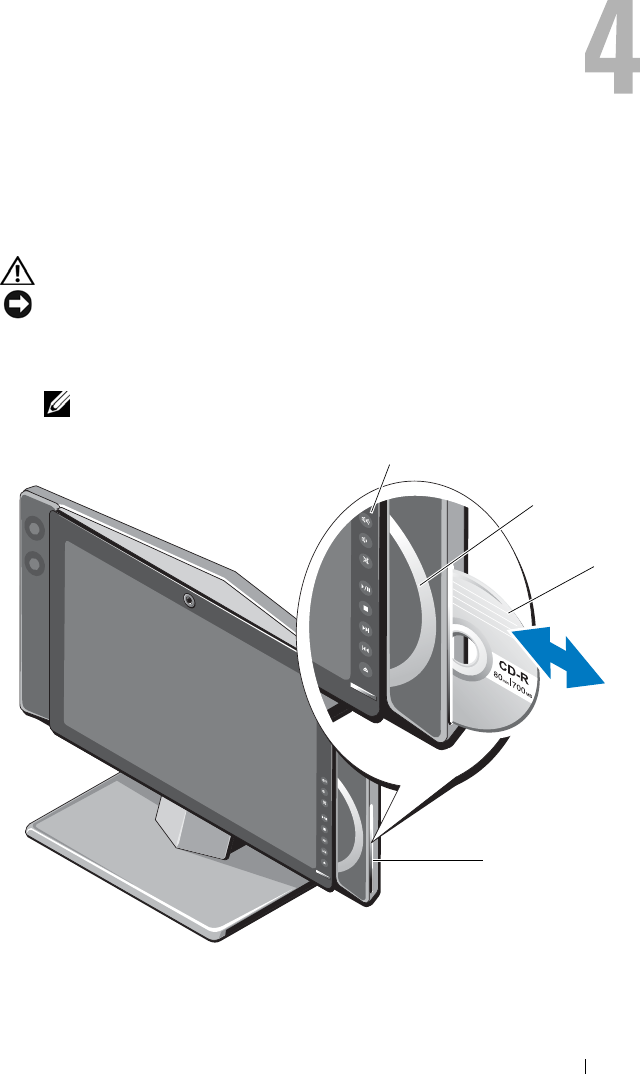
Using Multimedia 31
Using Multimedia
Using the Disc Drive
CAUTION: Do not insert any objects into the disc drive; it could be damaged.
NOTICE: Do not move the computer while playing CDs, DVDs, or other media.
1
Place the disc, label side facing forward, in the center of the disc slot.
2
Gently push the disc into the disk slot.
NOTE: This step may require you to push the disc farther than you expect.
1 media control buttons 2 disc indicator
3 disc 4 disc-slot indicator
2
4
1
3
book.book Page 31 Thursday, August 16, 2007 9:44 AM
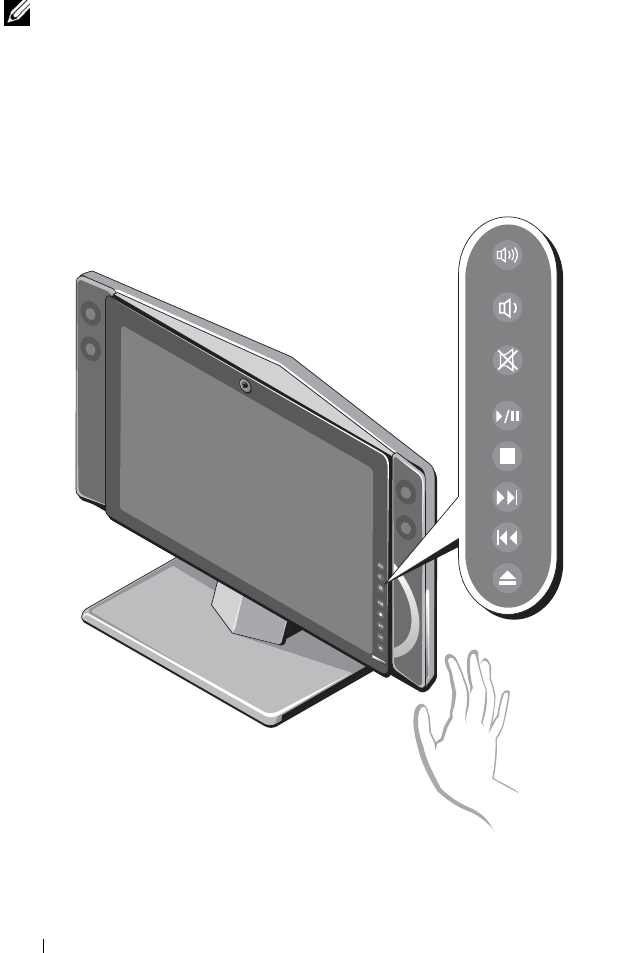
32 Using Multimedia
Media Control Buttons
NOTE: The media control buttons are capacitive buttons, and as such, may feel
different from other buttons when pressed.
The top four media control buttons to the right of your display may flash
during startup.
The media control buttons only light up when the user’s hand is detected in
close proximity to the right of the display. Your keyboard may also incorporate
some of these media control buttons.
book.book Page 32 Thursday, August 16, 2007 9:44 AM
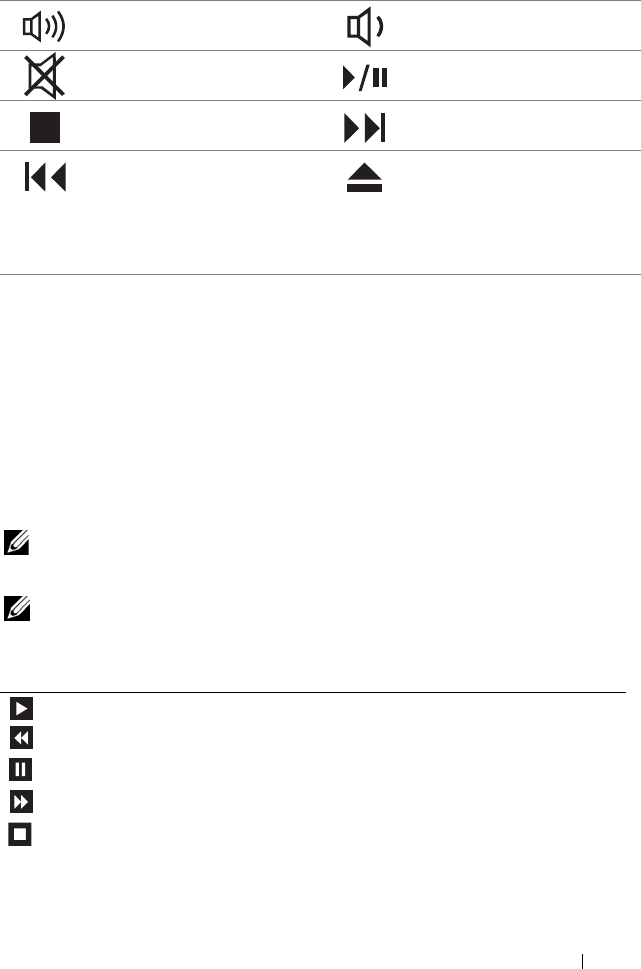
Using Multimedia 33
Disc and Disc-Slot Indicators
Either the disc or disc-slot indicator lights up when a user’s hand is detected
in its vicinity. The disc indicator lights up when the drive is occupied and the
disc-slot indicator lights up when it is empty.
CD and DVD Software
To format CDs for storing data, to create music CDs, or to copy CDs, see the
CD software that came with your computer.
NOTE: Ensure that you follow all copyright laws when you create CDs.
CD player software includes the following basic buttons:
NOTE: You should also be able to use the media control buttons to the right of your
display and if you have the optional optimized wireless keyboard, the media control
buttons on your keyboard.
Turn the volume up. Turn the volume down.
Mute the sound. Play or pause.
Stop. Play the next track.
Play the previous track. Eject.
NOTE: After you press Eject,
there may be a slight pause
before the disc ejects.
Play.
Move backward within the current track.
Pause.
Move forward within the current track.
Stop.
book.book Page 33 Thursday, August 16, 2007 9:44 AM
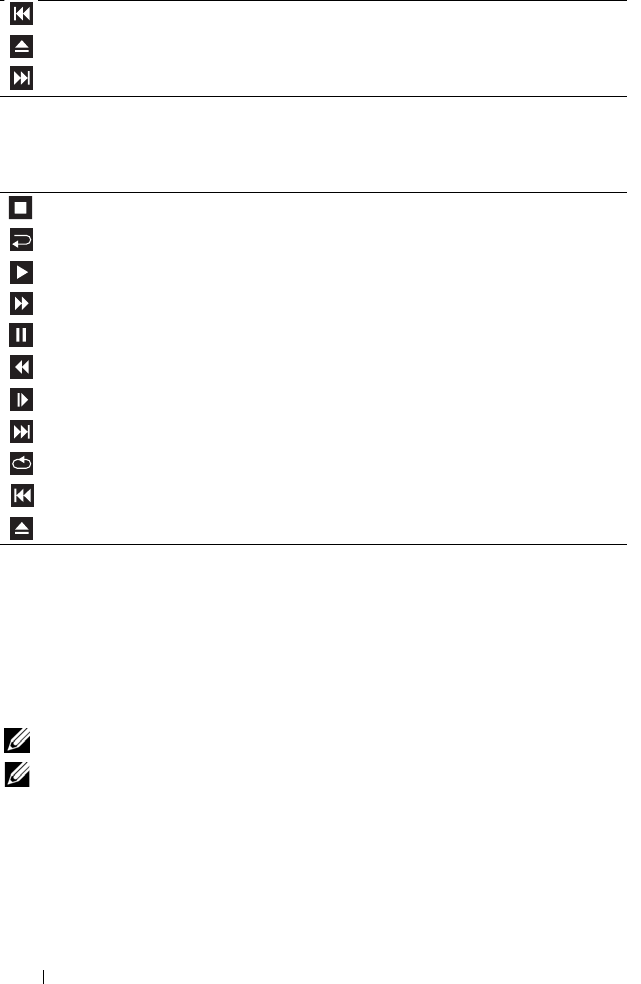
34 Using Multimedia
DVD and Blu-Ray Disc™ (BD) player software includes the following basic
buttons:
For more information on playing CDs, DVDs, or Blu-ray Discs (BDs), click
Help in the media player interface (if available).
Copying CD, DVD, and Blu-ray Disc™ (BD) Media
This section applies only to computers that have a DVD+/-RW drive or a
BD-RE drive.
NOTE: Ensure that you observe all copyright laws when copying media.
NOTE: The types of optical drives offered by Dell may vary by country.
The following instructions explain how to make a copy of a CD, DVD, or BD
using Roxio Creator. You can also use Roxio Creator for other purposes, such
as creating music CDs from audio files stored on your computer or backing
up important data. For help, open Roxio Creator, and then press <F1>.
Go to the previous track.
Eject.
Go to the next track.
Stop.
Restart the current chapter.
Play.
Fast forward.
Pause.
Fast reverse.
Advance a single frame while in pause mode.
Go to the next title or chapter.
Continuously play the current title or chapter.
Go to the previous title or chapter.
Eject.
book.book Page 34 Thursday, August 16, 2007 9:44 AM

Using Multimedia 35
The DVD drives and BD drives installed in Dell computers do not support
HD-DVD media. For a list of supported media formats, see "Using Blank CD,
DVD, and BD Media" on page 35.
How to Copy a CD, DVD, or BD
NOTE: BD media can only be copied to other BD media. DVD media can only be
copied to other DVD-recordable/rewritable media. CD media can only be copied to
other CD-recordable/rewritable media.
NOTE: Copying a BD-R to BD-RE will not produce an exact copy. Border
information will be lost.
NOTE: Most commercial DVDs and BDs have copyright protection and cannot be
copied using Roxio Creator.
1
Open Roxio Creator.
2
Under the
Copy
tab, click
Disc Copy
.
3
Insert the source disc into the drive, ensure that the settings are correct,
and then click the
Copy Disc
button to continue.
The computer reads your source disc and copies the data to a temporary
folder on your computer hard drive.
4
When prompted, insert a blank disc into the drive and click
OK
.
Once you have finished copying the source disc, the disc that you have
created automatically ejects.
Using Blank CD, DVD, and BD Media
CD-writable drives can only write to CD recording media. DVD-writable
drives can write to both CD and DVD recording media. BD-writable drives
can write to CD, DVD and BD recording media.
Use blank CD-Rs to record music or permanently store data files. After
creating a CD-R, you cannot write to that CD-R again (see the Sonic
documentation for more information). Use blank CD-RWs if you plan to
erase, rewrite, or update information on that disc later.
Blank DVD+/-R or BD-R media can be used to permanently store large
amounts of information. After you create a DVD+/-R or BD-R, you cannot
write to that disc again if the disc is "finalized" or "closed" during the final
stage of the disc creation process. Use blank DVD+/-RW or BD-RE media if
you plan to erase, rewrite, or update information on that disc later.
book.book Page 35 Thursday, August 16, 2007 9:44 AM
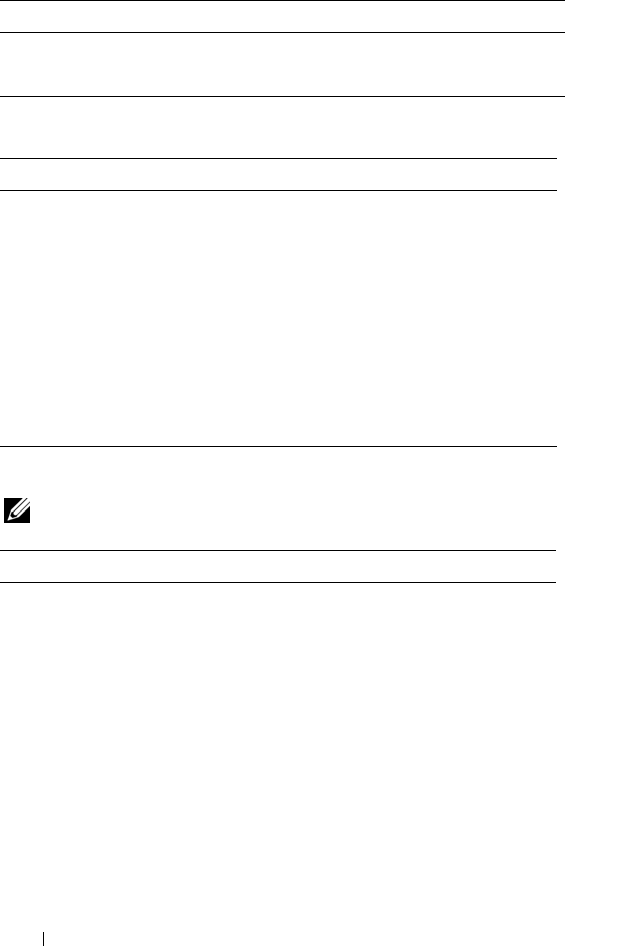
36 Using Multimedia
CD-Writable Drives
DVD-Writable Drives
BD-Writable Drives
NOTE: Your BD-writable drive may not read / write HD-DVD media.
Media Type Read Write Rewritable
CD-R Yes Yes No
CD-RW Yes Yes Yes
Media Type Read Write Rewritable
CD-R Yes Yes No
CD-RW Yes Yes Yes
DVD+R Yes Yes No
DVD-R Yes Yes No
DVD+RW Yes Yes Yes
DVD-RW Yes Yes Yes
DVD+R DL Yes Yes No
DVD-R DL Yes No No
Media Type Read Write Rewritable
CD-R Yes Yes No
CD-RW Yes Yes Yes
DVD+R Yes Yes No
DVD-R Yes Yes No
DVD+RW Yes Yes Yes
DVD-RW Yes Yes Yes
DVD+R DL Yes Yes No
DVD-R DL Yes No No
book.book Page 36 Thursday, August 16, 2007 9:44 AM

Using Multimedia 37
Helpful Tips
• Use Microsoft
®
Windows
®
Explorer to drag and drop files to a CD-R or
CD-RW only after you start
Roxio Creator
and open a Creator project.
• Do not burn a blank CD-R or CD-RW to its maximum capacity; for
example, do not copy a 650-MB file to a blank 650-MB CD. The CD-RW
drive needs 1–2 MB of the blank space to finalize the recording.
• Use CD-Rs to burn music CDs that you want to play in regular stereos.
CD-RWs do not play in most home or car stereos.
• Music MP3 files can be played only on MP3 players or on computers that
have MP3 software installed.
• Use a blank CD-RW to practice CD recording until you are familiar with
CD recording techniques. If you make a mistake, you can erase the data on
the CD-RW and try again. You can also use blank CD-RWs to test music
file projects before you record the project permanently to a blank CD-R.
• You cannot create audio DVDs with
Roxio Creator.
• Commercially available DVD players used in home theater systems may
not support all available DVD formats. For a list of formats supported by
your DVD player, see the documentation provided with your DVD player
or contact the manufacturer.
• Commercially available BD players used in home theater systems may not
support all available BD formats. For a list of formats supported by your
BD player, see the documentation provided with your BD player or contact
the manufacturer.
• See the Roxio website at
www.sonic.com
for additional information.
BD-R Yes Yes No
BD-RE Yes Yes Yes
Media Type Read Write Rewritable
book.book Page 37 Thursday, August 16, 2007 9:44 AM

38 Using Multimedia
Adjusting the Volume
NOTE: When the speakers are muted, you do not hear the CD or DVD playing.
1
Open the
Volume Control
window.
2
Click and drag the bar in the
Volume Control
column and slide it up or
down to increase or decrease the volume.
For more information on volume control options, click Help in the Volume
Control window.
Adjusting the Picture
If an error message notifies you that the current resolution and color depth
are using too much memory and preventing DVD playback, adjust the display
properties.
If your computer is running Microsoft Windows Vista™ Operating System:
1
Click the Windows Vista Start button ,
click
Control Panel
, and then
click
Appearance and Personalization
.
2
Under
Personalization
, click
Adjust Screen Resolution
.
The
Display Properties
window appears.
3
Under
Resolution:
click and drag the bar reduce the resolution setting.
4
In the drop-down menu under
Colors:
, click
Medium (16 bit)
.
5
Click
OK
.
Enabling S/PDIF Digital Audio
If your computer has a DVD drive, you can enable digital audio for DVD
playback.
1
Launch the
Cyberlink PowerDVD
application.
2
Insert a DVD into the DVD drive.
If the DVD begins playing, click the
Stop
button.
3
Click the
Settings
option.
4
Click the
DVD
option.
5
Click the
DVD Audio Setting
icon.
book.book Page 38 Thursday, August 16, 2007 9:44 AM

Using Multimedia 39
6
Click the arrows beside the
Speaker Configuration
setting to scroll
through the options, and then select the
SPDIF
option.
7
Click the
Back
button once, and then click the
Back
button again to
return to the main menu screen.
Enabling S/PDIF in the Windows Audio Driver
1
Double-click the speaker icon in the Windows notification area.
2
Click the
Options
menu and then click
Advanced Controls
.
3
Click
Advanced
.
4
Click
S/PDIF Interface
.
5
Click
Close
.
6
Click
OK
.
Setting Up the Cyberlink (CL) Headphones
NOTE: The CL headphone feature is available only if your computer has a DVD drive.
If your computer has a DVD drive, you can enable digital audio for DVD
playback.
1
Launch the
Cyberlink PowerDVD
program.
2
Insert a DVD into the DVD drive.
If the DVD begins playing, click the
Stop
button.
3
Click the
Settings
option.
4
Click the
DVD
option.
5
Click the
DVD Audio Setting
icon.
6
Click the arrows beside the
Speaker Configuration
setting to scroll
through the options, and select the
Headphones
option.
7
Click the arrows beside the
Audio listening mode
setting to scroll through
the options, and select the
CL Headphone
option.
8
Click the arrows beside the
Dynamic range compression
option to select
the most suitable option.
9
Click the
Back
button once, and then click the
Back
button again to
return to the main menu screen.
book.book Page 39 Thursday, August 16, 2007 9:44 AM

40 Using Multimedia
book.book Page 40 Thursday, August 16, 2007 9:44 AM
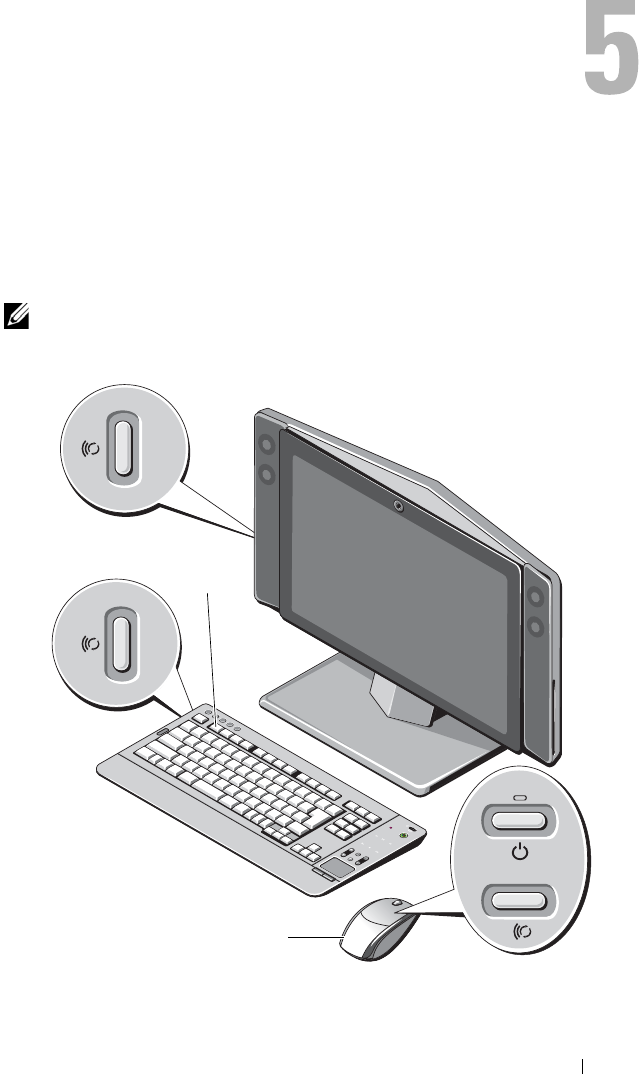
Using the Optional Wireless Keyboard and Mouse 41
Using the Optional Wireless
Keyboard and Mouse
Your Dell™ XPS™ computer supports a special wireless (non-Bluetooth)
keyboard and mouse which are optimized for use with your computer.
NOTE: The optional keyboard and mouse have special features which may not be
available on other devices that could be used with your computer.
1 optimized wireless keyboard 2 optimized wireless mouse
2
1
book.book Page 41 Thursday, August 16, 2007 9:44 AM
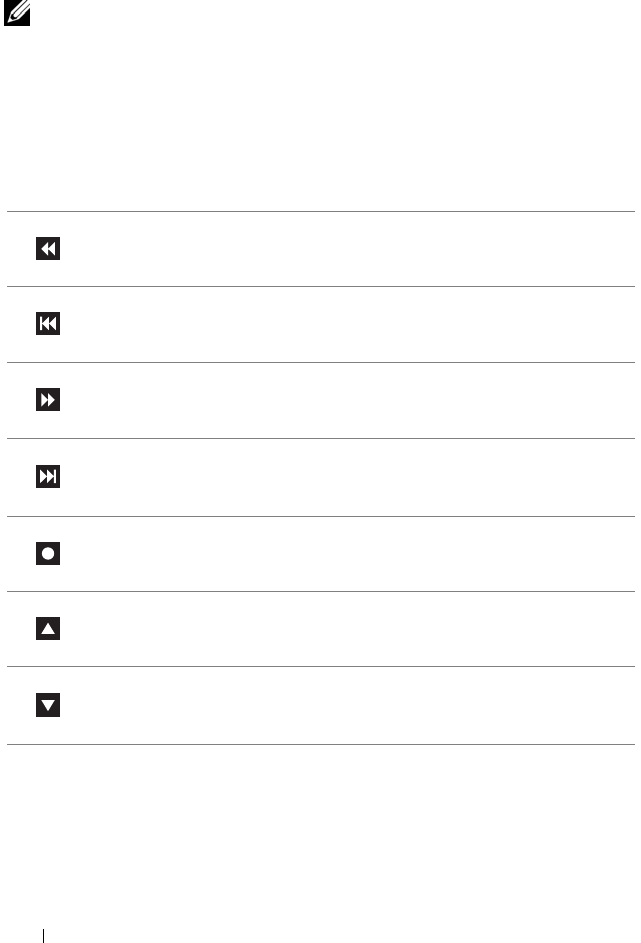
42 Using the Optional Wireless Keyboard and Mouse
Media Control Keys
NOTE: The media control keys are capacitive buttons, and as such, may feel
different from other buttons when pressed.
The optional wireless keyboard has media control keys to aid you in quick
control of volume and playback functions on your computer. These buttons
light up when you press them.
In addition to the basic media control keys shown in "Using Multimedia" on
page 31, the optional keyboard also incorporates the following keys.
Press to rewind within the current track/chapter.
Press once to go back to the start of the current playing track/chapter.
Press multiple times to skip back to previous track/chapters.
Press to fast-forward within the current track/chapter.
Press once to skip forward one track/chapter. Press multiple times to skip
forward multiple tracks/chapters.
Press to start or stop recording.
Press to change channels (increasing).
Press to change channels (decreasing).
book.book Page 42 Thursday, August 16, 2007 9:44 AM
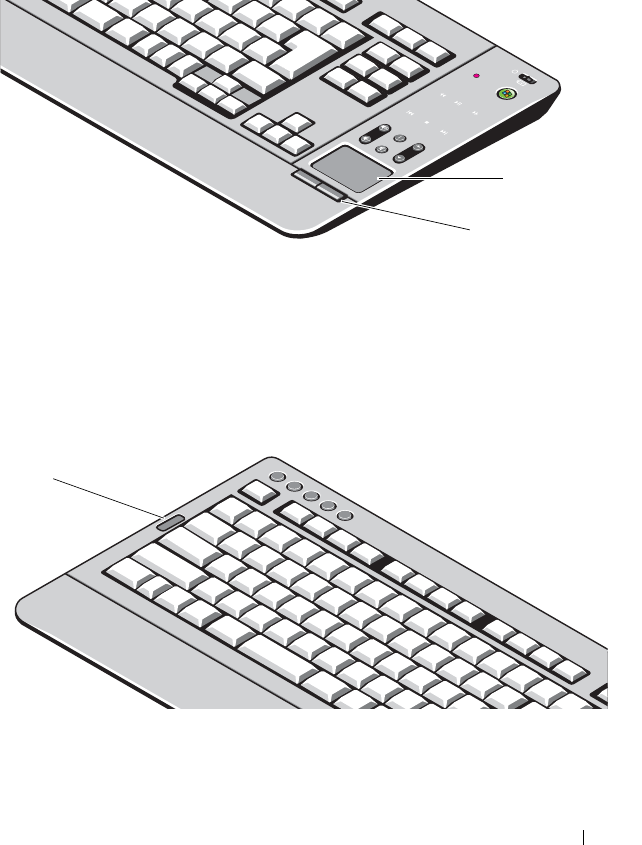
Using the Optional Wireless Keyboard and Mouse 43
Using the Touch Pad
The touch pad detects the pressure and movement of your finger to allow you
to move the cursor on the display. Use the touch pad and touch-pad buttons
as you would use a mouse.
• To move the cursor, lightly slide your finger over the touch pad.
• To select an object, lightly tap once on the surface of the touch pad or use
your thumb to press the left touch-pad button
or
the alternate left touch-
pad button to the left of the keyboard.
1 touch pad 2 touch-pad buttons
1 alternate left touch-pad button
2
1
1
book.book Page 43 Thursday, August 16, 2007 9:44 AM

44 Using the Optional Wireless Keyboard and Mouse
• To select and move (or drag) an object, position the cursor on the object
and tap twice on the touch pad. On the second tap, leave your finger on
the touch pad and move the selected object by sliding your finger over the
surface.
• To double-click an object, position the cursor on the object and tap twice
on the touch pad or use your thumb to press the left touch-pad button
twice (the alternate left touch-pad button to the left of the keyboard can
also be used).
Customizing the Touch Pad
You can use the Mouse Properties window to disable the touch pad or adjust
its settings.
If your computer is running Microsoft Windows Vista™ Operating System:
Click the Windows Vista Start button , click Control Panel, and then
click Mouse Properties.
Re-Syncing Your Optional Wireless Mouse or
Keyboard with Your Computer
If for any reason, you need to re-sync your optional (non-Bluetooth) wireless
keyboard or mouse with your computer, follow these instructions:
1
Turn the computer on.
2
Turn on the keyboard or mouse.
book.book Page 44 Thursday, August 16, 2007 9:44 AM
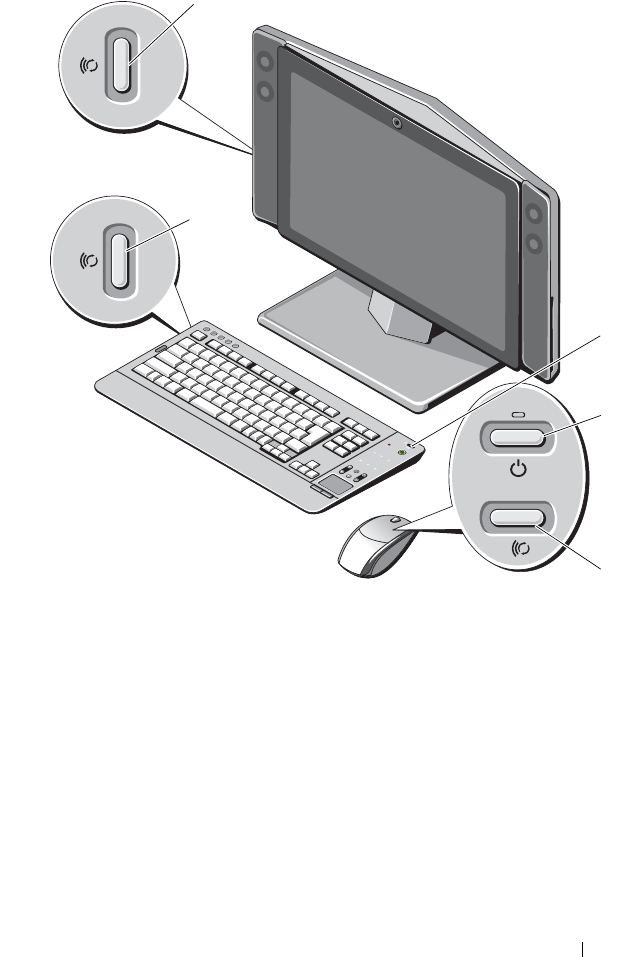
Using the Optional Wireless Keyboard and Mouse 45
3
Press the sync button to the rear of your computer’s left speaker.
4
Press the sync button on the mouse or keyboard.
The mouse or keyboard should now be paired with your computer. If you
experience any problems, see "Troubleshooting" on page 51.
1 computer sync button 2 keyboard sync button
3 keyboard power switch 4 mouse power button
5 mouse sync button
1
5
2
4
3
book.book Page 45 Thursday, August 16, 2007 9:44 AM

46 Using the Optional Wireless Keyboard and Mouse
Key Combinations
To adjust keyboard operation, such as the character repeat rate, open the
Control Panel, click Printers and Other Hardware, and click Keyboard. For
information about the Control Panel, see the Windows Help and Support
Center. To access the Help and Support Center, see "Windows Help and
Support" on page 13.
<Fn> and up-arrow key Increases brightness on the integrated
display.
<Fn> and down-arrow key Decreases brightness on the integrated
display.
<Fn> and right-arrow key Toggles the display on and off without
changing the overall operating state.
book.book Page 46 Thursday, August 16, 2007 9:44 AM

Using the Display 47
Using the Display
Use the display power button on the lower-right of your display to turn off the
display without affecting the operating state of your computer. See "Front
View of the Computer" on page 15.
Adjusting Brightness
You can press the following keys to adjust display brightness:
• Press <Fn> and the up-arrow key to increase brightness on the integrated
display only (not on an external monitor).
• Press <Fn> and the down-arrow key to decrease brightness on the
integrated display only (not on an external monitor).
Making Images and Text Look Bigger or Sharper
NOTE: If you change the display resolution from the current settings, the image
may appear blurry or text may be hard to read if you change the resolution to one
not supported by your computer and display. Before you change any of the display
settings, make a note of the current settings so you can change back to the
previous settings if you need to.
You can enhance the legibility of text and change the appearance of images
on the screen by adjusting display resolution. As you increase resolution,
items appear smaller on the screen. In contrast, lower resolution causes text
and images to appear larger and can benefit people with vision impairments.
To display a program at a specific resolution, both the video card and the
display must support the program, and the necessary video drivers must be
installed.
NOTE: Use only the Dell-installed video drivers, which are designed to offer the
best performance with your Dell-installed operating system.
If you choose a resolution or color palette that is higher than the display
supports, the settings adjust automatically to the closest supported values.
To set the display resolution and refresh rate for your display, perform the
steps.
book.book Page 47 Thursday, August 16, 2007 9:44 AM

48 Using the Display
If your computer is running Windows Vista™:
1
Click the Windows Vista Start button , and click
Control Panel
.
2
Under
Appearance and Personalization
, click
Adjust screen resolution
.
3
In the
Display Settings
window, under
Resolution
, slide the slide bar to
the left/right to decrease/increase the screen resolution.
4
Click
How do I get the best display?
for further instructions.
book.book Page 48 Thursday, August 16, 2007 9:44 AM

Cleaning Your Computer 49
Cleaning Your Computer
CAUTION: Before you begin any of the procedures in this section, follow the
safety instructions in the Product Information Guide.
Computer and Display
CAUTION: Before you clean your computer, disconnect the computer from the
electrical outlet. Clean your computer with a soft cloth dampened with water. Do
not use liquid or aerosol cleaners, which may contain flammable substances.
NOTICE: To avoid damaging the computer or display, do not spray cleaning solution
directly onto the display. Only use products specifically designed for cleaning
displays, and follow the instructions that are included with the product.
NOTE: A soft, lint-free cloth has been provided for your computer in the binder that
came with the computer accessory kit.
• Moisten a soft, lint-free cloth with either water or a display cleaner, and
wipe the display until it is clean.
• Moisten a soft, lint-free cloth with water and wipe the computer and
keyboard. Do not allow water from the cloth to seep between the touch
pad and the surrounding palm rest.
CDs and DVDs
CAUTION: Do not clean the disc drive. Any attempt to clean the disc drive itself
could result in damage to the drive.
If you notice problems, such as skipping, with the playback quality of your
CDs or DVDs, try cleaning the discs.
1
Hold the disc by its outer edge. You can also touch the inside edge of the
center hole.
NOTICE: To avoid damaging the surface, do not wipe in a circular motion around
the disc.
book.book Page 49 Thursday, August 16, 2007 9:44 AM

50 Cleaning Your Computer
2
With a soft, lint-free cloth, gently wipe the bottom of the disc (the
unlabeled side) in a straight line from the center to the outer edge of the
disc.
For stubborn dirt, try using water or a diluted solution of water and mild
soap. You can also purchase commercial products that clean discs and
provide some protection from dust, fingerprints, and scratches. Cleaning
products for CDs are also safe to use on DVDs.
Keyboard and Touch Pad
1
If your keyboard has a power button, turn it off.
2
Remove any installed batteries from the keyboard.
3
Use a can of compressed air to remove dust from between the keys on the
keyboard.
CAUTION: Clean your touchpad with a soft cloth dampened with water. Do not
use liquid or aerosol cleaners, which may contain flammable substances.
4
Moisten a soft, lint-free cloth with water, and wipe it gently across the
surface of the touch pad. Do not allow water from the cloth to seep
between the touch pad and the surrounding palm rest or keyboard surface.
book.book Page 50 Thursday, August 16, 2007 9:44 AM
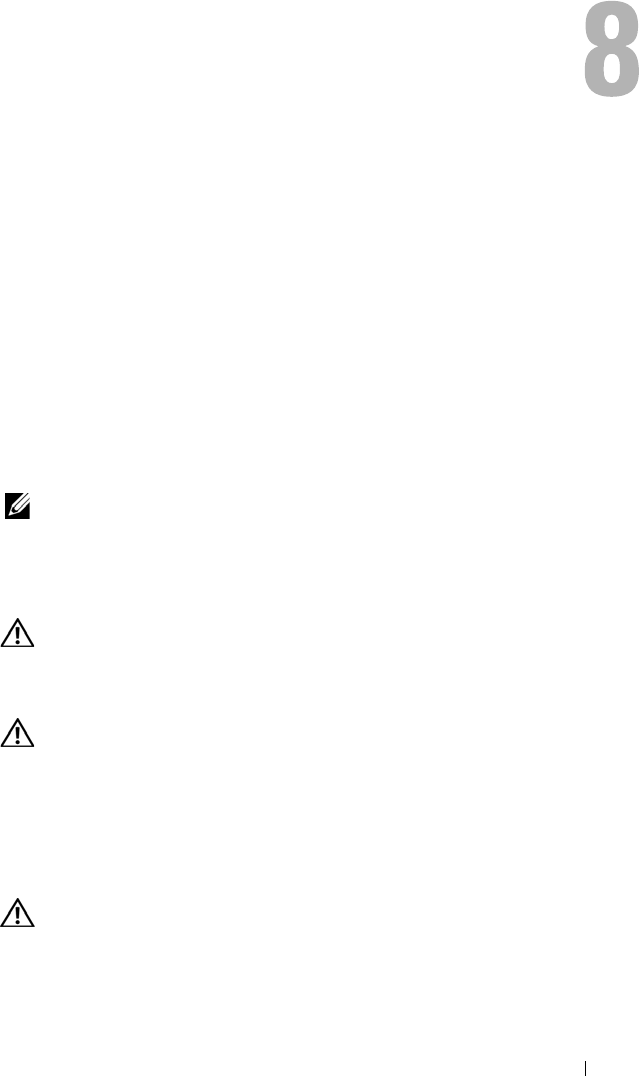
Troubleshooting 51
Troubleshooting
Solving Problems
Follow these tips when you troubleshoot your computer:
• If you added or removed a part before the problem started, review the
installation procedures and ensure that the part is correctly installed.
• If a peripheral device does not work, ensure that the device is properly
connected.
• If an error message appears on the screen, write down the exact message.
This message may help support personnel diagnose and fix the problem(s).
• If an error message occurs in a program, see the program’s documentation.
NOTE: The procedures in this document were written for the Windows default
view, so they may not apply if you set your Dell™ computer to the Windows Classic
view.
Battery Problems
CAUTION: There is a danger of a new battery exploding if it is incorrectly
installed. Replace the battery only with the same or equivalent type recommended
by the manufacturer. Discard used batteries according to the manufacturer's
instructions.
CAUTION: Before you begin any of the procedures in this section, follow the
safety instructions in the Product Information Guide.
CONTACT DELL —If you have to repeatedly reset time and date information after
turning on the computer, or if an incorrect time or date displays during start-up,
contact Dell (see "Contacting Dell" on page 95).
Display Problems
CAUTION: Before you begin any of the procedures in this section, follow the
safety instructions in the Product Information Guide.
book.book Page 51 Thursday, August 16, 2007 9:44 AM
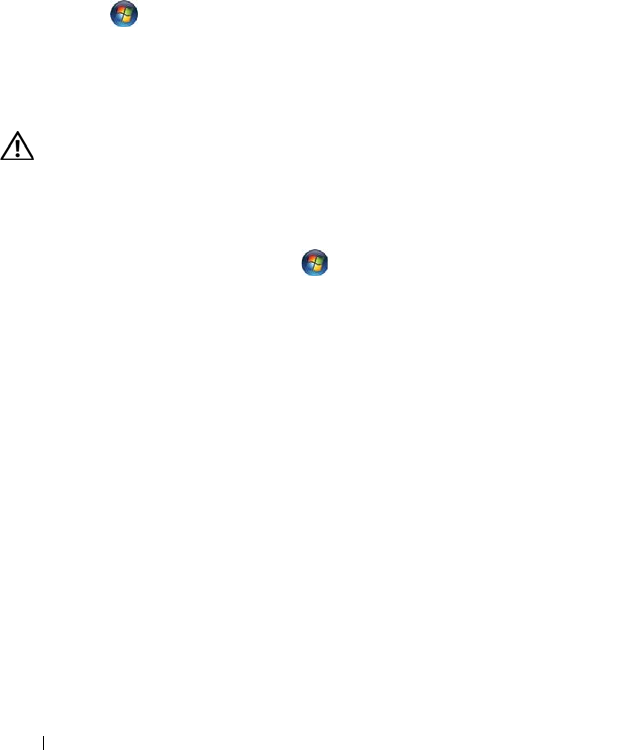
52 Troubleshooting
The screen is blank or difficult to read
ENSURE THAT THE DISPLAY IS TURNED ON —See "Front View of the Computer" on
page 15.
TEST THE ELECTRICAL OUTLET —Ensure that the electrical outlet is working by
testing it with another device, such as a lamp.
ROTATE THE DISPLAY TO ELIMINATE SUNLIGHT GLARE AND POSSIBLE
INTERFERENCE
ADJUST THE WINDOWS DISPLAY SETTINGS —
Windows Vista:
1
Click
Start
→
Control Panel
→
Hardware and Sound
→
Personalization
→
Display Settings
.
2
Adjust
Resolution
and
Colors settings,
as needed.
Drive Problems
CAUTION: Before you begin any of the procedures in this section, follow the
safety instructions in the Product Information Guide.
ENSURE THAT MICROSOFT® WINDOWS® RECOGNIZES THE DRIVE —
Windows Vista™:
• Click the Windows Vista Start button and click
Computer
.
If the drive is not listed, perform a full scan with your antivirus software to check for
and remove viruses. Viruses can sometimes prevent Windows from recognizing the
drive.
TEST THE DRIVE —
• Insert another disk to eliminate the possibility that the original drive is defective.
• Insert bootable media and restart the computer.
CLEAN THE DRIVE OR DISK —See "" on page 49.
CHECK ANY ACCESSIBLE CABLE CONNECTIONS
RUN THE HARDWARE TROUBLESHOOTER —See "Troubleshooting Software and
Hardware Problems in the Microsoft® Windows® Vista™ Operating Systems" on
page 78.
RUN THE DELL DIAGNOSTICS —See "Dell Diagnostics" on page 65.
book.book Page 52 Thursday, August 16, 2007 9:44 AM
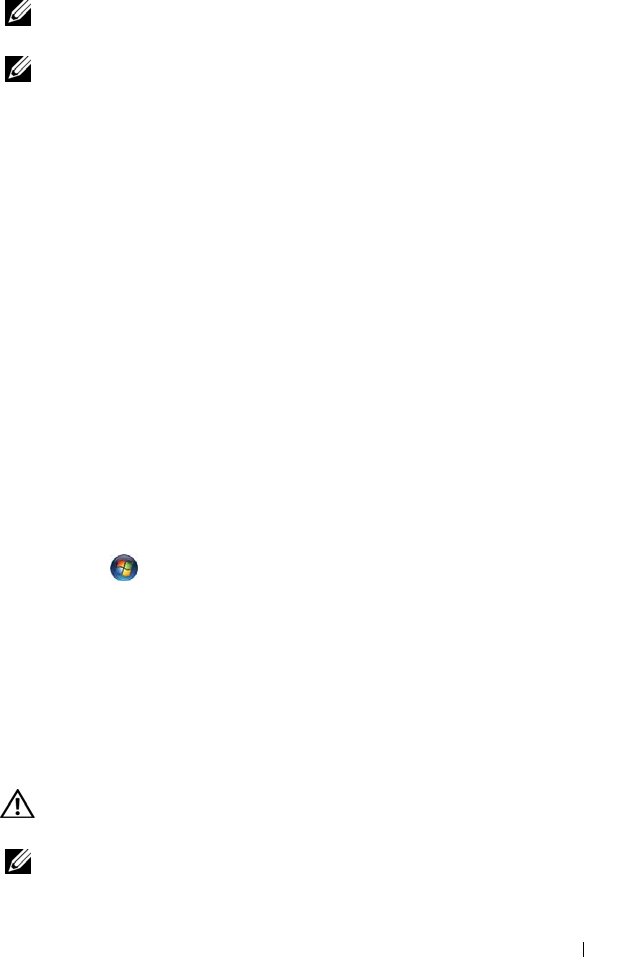
Troubleshooting 53
Optical drive problems
NOTE: High-speed optical drive vibration is normal and may cause noise, which
does not indicate a defect in the drive or the media.
NOTE: Because of different regions worldwide and different disc formats, not all
DVD titles work in all DVD drives.
ADJUST THE WINDOWS VOLUME CONTROL —
• Click the speaker icon in the lower-right corner of your screen.
• Ensure that the volume is turned up by clicking the slidebar and dragging it up.
• Ensure that the sound is not muted by clicking any boxes that are checked.
CHECK THE SPEAKERS —See "Sound and Speaker Problems" on page 62.
Problems writing to an optical drive
CLOSE OTHER PROGRAMS —The optical drive must receive a steady stream of data
during the writing process. If the stream is interrupted, an error occurs. Try closing all
programs before you write to the optical drive.
TURN OFF STANDBY MODE IN WINDOWS BEFORE WRITING TO A DISC —Search for
the keyword standby in Windows Help and Support for information on power
management modes.
Hard drive problems
RUN CHECK DISK —
Windows Vista:
1
Click
Start
and click
Computer
.
2
Right-click
Local Disk C:
.
3
Click
Properties
→
Tools
→
Check Now
.
The
User Account Control
window may appear. If you are an administrator on the
computer, click
Continue
; otherwise, contact your administrator to continue the
desired action.
4
Follow the instructions on the screen.
E-Mail and Internet Problems
CAUTION: Before you begin any of the procedures in this section, follow the
safety instructions in the Product Information Guide.
NOTE: Do not plug a telephone cable into the network adapter connector (see
"Back View of the Computer" on page 17).
book.book Page 53 Thursday, August 16, 2007 9:44 AM
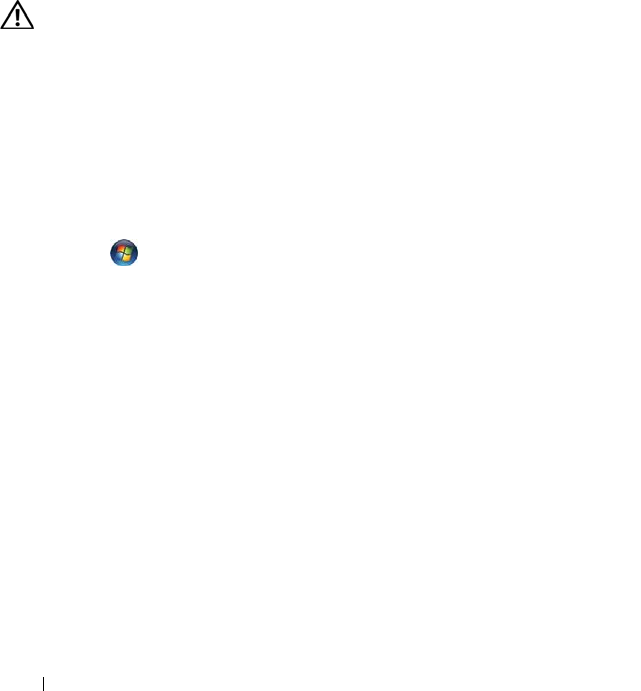
54 Troubleshooting
CHECK THE MICROSOFT® MAIL SECURITY SETTINGS —If you cannot open your
e-mail attachments:
1
In Microsoft Mail, click
Tools
→
Options
→
Security
.
2
Click
Do not allow attachments to be saved or opened that could potentially be a
virus
or
Block images and other external content in HTML e-mail
to remove the
checkmark, as needed.
ENSURE THAT YOU ARE CONNECTED TO THE INTERNET —Ensure that you have
subscribed to an Internet provider. With the Microsoft Mail e-mail program open,
click File. If Work Offline has a checkmark next to it, click the checkmark to remove it
and connect to the Internet. For help, contact your Internet service provider.
Error Messages
CAUTION: Before you begin any of the procedures in this section, follow the
safety instructions in the Product Information Guide.
If the error message is not listed, see the documentation for the operating
system or the program that was running when the message appeared.
A FILENAME CANNOT CONTAIN ANY OF THE FOLLOWING CHARACTERS: \ / : * ? “ <
> | — Do not use these characters in filenames.
A REQUIRED .DLL FILE WAS NOT FOUND —The program that you are trying to open
is missing an essential file. To remove and then reinstall the program:
Windows Vista:
1
Click
Start
→
Control Panel
→
Programs
→
Programs and Features
.
2
Select the program you want to remove.
3
Click
Uninstall
.
4
See the program documentation for installation instructions.
drive letter :\ IS NOT ACCESSIBLE. THE DEVICE IS NOT READY —The drive
cannot read the disk. Insert a disk into the drive and try again.
INSERT BOOTABLE MEDIA —Insert a bootable floppy disk, CD, or DVD.
NON-SYSTEM DISK ERROR —Remove the floppy disk from the floppy drive and
restart your computer.
NOT ENOUGH MEMORY OR RESOURCES. CLOSE SOME PROGRAMS AND TRY
AGAIN —Close all windows and open the program that you want to use. In some
cases, you may have to restart your computer to restore computer resources. If so, run
the program that you want to use first.
OPERATING SYSTEM NOT FOUND —Contact Dell (see "Contacting Dell" on
page 95).
book.book Page 54 Thursday, August 16, 2007 9:44 AM
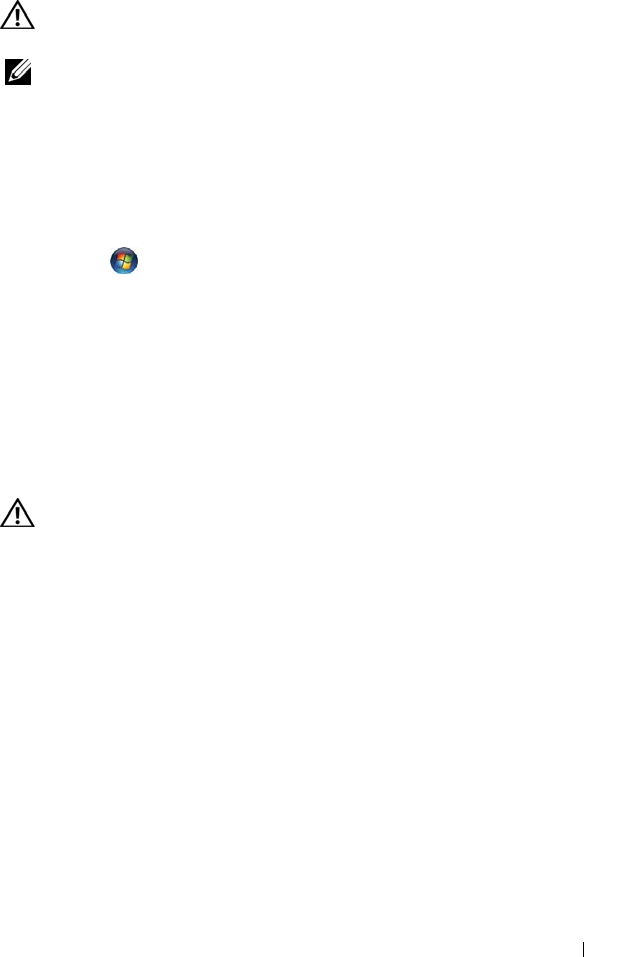
Troubleshooting 55
IEEE 1394 Device Problems
CAUTION: Before you begin any of the procedures in this section, follow the
safety instructions in the Product Information Guide.
NOTE: Your computer supports only IEEE 1394a standard.
ENSURE THAT THE CABLE FOR THE IEEE 1394 DEVICE IS PROPERLY INSERTED INTO
THE DEVICE AND INTO THE CONNECTOR ON THE COMPUTER
ENSURE THAT THE IEEE 1394 DEVICE IS ENABLED IN SYSTEM SETUP —See
"System Setup Options" on page 70.
ENSURE THAT THE IEEE 1394 DEVICE IS RECOGNIZED BY WINDOWS —
Windows Vista:
1
Click
Start
→
Control Panel
→
Hardware and Sound
.
2
Click
Device Manager.
If your IEEE 1394 device is listed, Windows recognizes the device.
IF YOU HAVE PROBLEMS WITH A DELL IEEE 1394 DEVICE —Contact Dell (see
"Contacting Dell" on page 95).
IF YOU HAVE PROBLEMS WITH AN IEEE 1394 DEVICE NOT PROVIDED BY DELL —
Contact the IEEE 1394 device manufacturer.
Keyboard Problems
CAUTION: Before you begin any of the procedures in this section, follow the
safety instructions in the Product Information Guide.
Wireless Keyboard
CHECK THE WIRELESS CONNECTION BETWEEN THE KEYBOARD AND YOUR
COMPUTER —
• Ensure that the keyboard is paired with your computer.
See "Re-Syncing Your
Optional Wireless Mouse or Keyboard with Your Computer
" on page 44
.
• Verify that the keyboard is turned on, if applicable. Some wireless keyboards have a
power button. If the keyboard has a power indicator, check the indicator.
• Ensure that the keyboard battery has not run low, if applicable. If the keyboard has a
battery indicator, check the indicator.
• Restart the computer.
book.book Page 55 Thursday, August 16, 2007 9:44 AM

56 Troubleshooting
USB Keyboard
CHECK THE KEYBOARD CABLE —
• Ensure that the keyboard cable is firmly connected to the computer.
• Shut down the computer, reconnect the keyboard cable as shown on the setup
diagram for your computer, and then restart the computer.
• Ensure that the cable is not damaged or frayed and check cable connectors for bent or
broken pins. Straighten any bent pins.
• Remove any keyboard extension cables and connect the keyboard directly to the
computer.
Any Keyboard
TEST THE KEYBOARD —Connect or pair a properly working keyboard to the
computer, then try using the keyboard. See "Re-Syncing Your Optional Wireless
Mouse or Keyboard with Your Computer" on page 44.
RUN THE HARDWARE TROUBLESHOOTER —See "Troubleshooting Software and
Hardware Problems in the Microsoft® Windows® Vista™ Operating Systems" on
page 78.
SEE YOUR KEYBOARD DOCUMENTATION —If your keyboard has documentation, see
if it has special troubleshooting suggestions or recommendations.
Lockups and Software Problems
CAUTION: Before you begin any of the procedures in this section, follow the
safety instructions in the Product Information Guide.
The computer does not start up
ENSURE THAT THE POWER CABLE IS FIRMLY CONNECTED TO THE COMPUTER AND TO
THE ELECTRICAL OUTLET
The computer stops responding
NOTICE: You may lose data if you are unable to perform an operating system
shutdown.
TURN THE COMPUTER OFF —If you are unable to get a response by pressing a key on
your keyboard or moving your mouse, press and hold the power button for at least 8 to
10 seconds (until the computer turns off), and then restart your computer.
book.book Page 56 Thursday, August 16, 2007 9:44 AM

Troubleshooting 57
A program stops responding
END THE PROGRAM —
1
Press <Ctrl><Shift><Esc> simultaneously to access the Task Manager.
2
Click the
Applications
tab.
3
Click to select the program that is no longer responding.
4
Click
End Task
.
A program crashes repeatedly
NOTE: Most software includes installation instructions in its documentation or on a
floppy disk, CD, or DVD.
CHECK THE SOFTWARE DOCUMENTATION —If necessary, uninstall and then reinstall
the program.
A program is designed for an earlier Windows operating system
RUN THE PROGRAM COMPATIBILITY WIZARD —
Windows Vista:
The Program Compatibility Wizard configures a program so that it runs in an
environment similar to non-Windows Vista operating system environments.
1
Click
Start
→
Control Panel
→
Programs
→
Use an older program with this
version of Windows.
2
In the welcome screen, click
Next
.
3
Follow the instructions on the screen.
A solid blue screen appears
TURN THE COMPUTER OFF —If you are unable to get a response by pressing a key on
your keyboard or moving your mouse, press and hold the power button for at least 8 to
10 seconds (until the computer turns off), and then restart your computer.
Other software problems
CHECK THE SOFTWARE DOCUMENTATION OR CONTACT THE SOFTWARE
MANUFACTURER FOR TROUBLESHOOTING INFORMATION —
• Ensure that the program is compatible with the operating system installed on your
computer.
• Ensure that your computer meets the minimum hardware requirements needed to
run the software. See the software documentation for information.
• Ensure that the program is installed and configured properly.
book.book Page 57 Thursday, August 16, 2007 9:44 AM

58 Troubleshooting
• Verify that the device drivers do not conflict with the program.
• If necessary, uninstall and then reinstall the program.
BACK UP YOUR FILES IMMEDIATELY
USE A VIRUS-SCANNING PROGRAM TO CHECK THE HARD DRIVE, FLOPPY DISKS,
CDS, OR DVDS
SAVE AND CLOSE ANY OPEN FILES OR PROGRAMS AND SHUT DOWN YOUR
COMPUTER THROUGH THE START MENU
Memory Problems
CAUTION: Before you begin any of the procedures in this section, follow the
safety instructions in the Product Information Guide.
IF YOU RECEIVE AN INSUFFICIENT MEMORY MESSAGE —
• Save and close any open files and exit any open programs you are not using to see if
that resolves the problem.
• See the software documentation for minimum memory requirements. If necessary,
install additional memory (see
"Contacting Dell
" on page 95).
• Run the Dell Diagnostics (see
"Dell Diagnostics
" on page 65).
IF YOU EXPERIENCE OTHER MEMORY PROBLEMS —
• Ensure that the memory you are using is supported by your computer. For more
information about the type of memory supported by your computer, see
"Specifications
" on page 83.
• Run the Dell Diagnostics (see
"Dell Diagnostics
" on page 65).
Mouse Problems
CAUTION: Before you begin any of the procedures in this section, follow the
safety instructions in the Product Information Guide.
Wireless Mouse
CHECK THE WIRELESS CONNECTION BETWEEN THE MOUSE AND YOUR
COMPUTER —
• Ensure that the mouse is paired with your computer.
See "Re-Syncing Your Optional
Wireless Mouse or Keyboard with Your Computer
" on page 44
.
• Verify that the mouse is turned on.
Some mice include a power indicator.
• Ensure that the mouse battery has not run low.
Some mice include a battery-charge
indicator.
book.book Page 58 Thursday, August 16, 2007 9:44 AM

Troubleshooting 59
• Restart your computer.
• See your mouse documentation.
TO VERIFY THAT THE PROBLEM IS WITH THE MOUSE, CHECK THE TOUCH PAD —
1
Turn off the mouse.
2
At the Windows
desktop, use the touch pad to move the cursor around, select an icon,
and open it.
If the touch pad operates correctly, the mouse may be defective.
USB Mouse
CHECK THE MOUSE CABLE —
• Ensure that neither the cable or the cable connectors are visibly damaged.
• Remove any mouse extension cables, and connect the mouse directly to the computer.
• Verify that the mouse cable is connected as shown on the setup diagram for your
computer.
RESTART THE COMPUTER —
1
Simultaneously press <Ctrl><Esc> to display the
Start
menu.
2
Press <
u>
,
press the up- and down-arrow keys
to highlight
Shut down
or
Tu rn
Off
, and then press <Enter>.
3
After the computer turns off, reconnect the mouse cable as shown on the setup
diagram.
4
Turn on the computer.
TO VERIFY THAT THE PROBLEM IS WITH THE MOUSE, CHECK THE TOUCH PAD —
1
Shut down the computer.
2
Disconnect the mouse.
3
Turn on the computer.
4
At the Windows
desktop, use the touch pad to move the cursor around, select an icon,
and open it.
5
If the touch pad operates correctly, the mouse may be defective.
Any Mouse
TEST THE MOUSE —Connect a properly working mouse to the computer, then try
using the mouse.
book.book Page 59 Thursday, August 16, 2007 9:44 AM

60 Troubleshooting
CHECK THE MOUSE SETTINGS —
Windows Vista:
1
Click
Start
→
Control Panel
→
Hardware and Sound
→
Mouse
.
2
Adjust the settings as needed.
REINSTALL THE MOUSE DRIVER —See
(see
"Drivers" on page 75
)
.
RUN THE HARDWARE TROUBLESHOOTER —See "Troubleshooting Software and
Hardware Problems in the Microsoft® Windows® Vista™ Operating Systems" on
page 78.
Network Problems
CAUTION: Before you begin any of the procedures in this section, follow the
safety instructions in the Product Information Guide.
CHECK THE NETWORK CABLE CONNECTOR —Ensure that the network cable is firmly
inserted into the network connector on the back of the computer and the network
jack.
CHECK THE NETWORK LIGHTS ON THE BACK OF THE COMPUTER —If the link
integrity light is off (see "Controls and Lights" on page 87), no network
communication is occurring. Replace the network cable.
RESTART THE COMPUTER AND LOG ON TO THE NETWORK AGAIN
CHECK YOUR NETWORK SETTINGS —Contact your network administrator or the
person who set up your network to verify that your network settings are correct and
that the network is functioning.
RUN THE HARDWARE TROUBLESHOOTER —See "Troubleshooting Software and
Hardware Problems in the Microsoft® Windows® Vista™ Operating Systems" on
page 78.
Power Problems
CAUTION: Before you begin any of the procedures in this section, follow the
safety instructions in the Product Information Guide.
IF THE POWER LIGHT IS BLUE AND THE COMPUTER IS NOT RESPONDING —
Contact Dell, see "Contacting Dell" on page 95.
IF THE POWER LIGHT IS BLINKING BLUE —The computer is in standby mode. Press
a key on the keyboard, move the mouse, or press the power button to resume normal
operation.
book.book Page 60 Thursday, August 16, 2007 9:44 AM

Troubleshooting 61
IF THE POWER LIGHT IS OFF —The computer is either turned off or is not receiving
power.
• Reseat the power cable in the power connector on the back of the computer and the
electrical outlet.
• Bypass power strips, power extension cables, and other power protection devices to
verify that the computer turns on properly.
• Ensure that any power strips being used are plugged into an electrical outlet and are
turned on.
• Ensure that the electrical outlet is working by testing it with another device, such as a
lamp.
• Contact Dell, (see
"Contacting Dell
" on page 95).
IF THE POWER LIGHT IS AMBER —Contact Dell, see "Contacting Dell" on page 95.
ELIMINATE INTERFERENCE —Some possible causes of interference are:
• Power, keyboard, and mouse extension cables.
• Too many devices connected to the same power strip.
• Multiple power strips connected to the same electrical outlet.
Printer Problems
CAUTION: Before you begin any of the procedures in this section, follow the
safety instructions in the Product Information Guide.
NOTE: If you need technical assistance for your printer, contact the printer’s
manufacturer.
CHECK THE PRINTER DOCUMENTATION —See the printer documentation for setup
and troubleshooting information.
ENSURE THAT THE PRINTER IS TURNED ON
CHECK THE PRINTER CABLE CONNECTIONS —
• See the printer documentation for cable connection information.
• Ensure that the printer cables are securely connected to the printer and the computer.
TEST THE ELECTRICAL OUTLET —Ensure that the electrical outlet is working by
testing it with another device, such as a lamp.
VERIFY THAT THE PRINTER IS RECOGNIZED BY WINDOWS —
Windows Vista:
1
Click
Start
→
Control Panel
→
Hardware and Sound
→
Printer
.
2
If the printer is listed, right-click the printer icon.
book.book Page 61 Thursday, August 16, 2007 9:44 AM